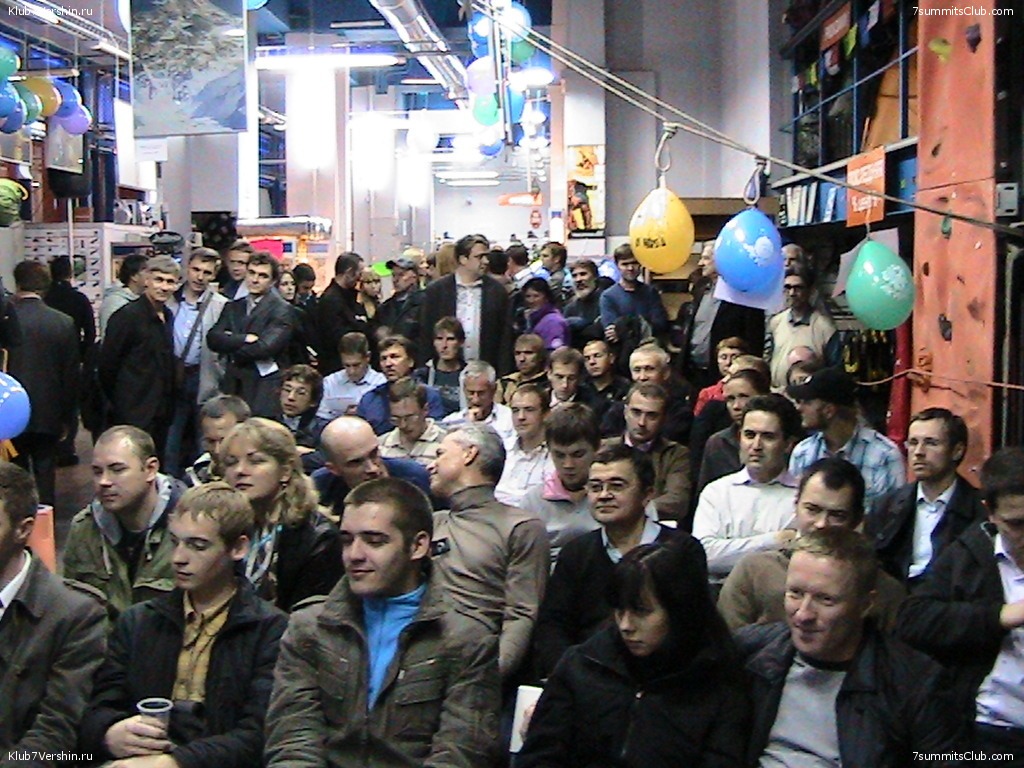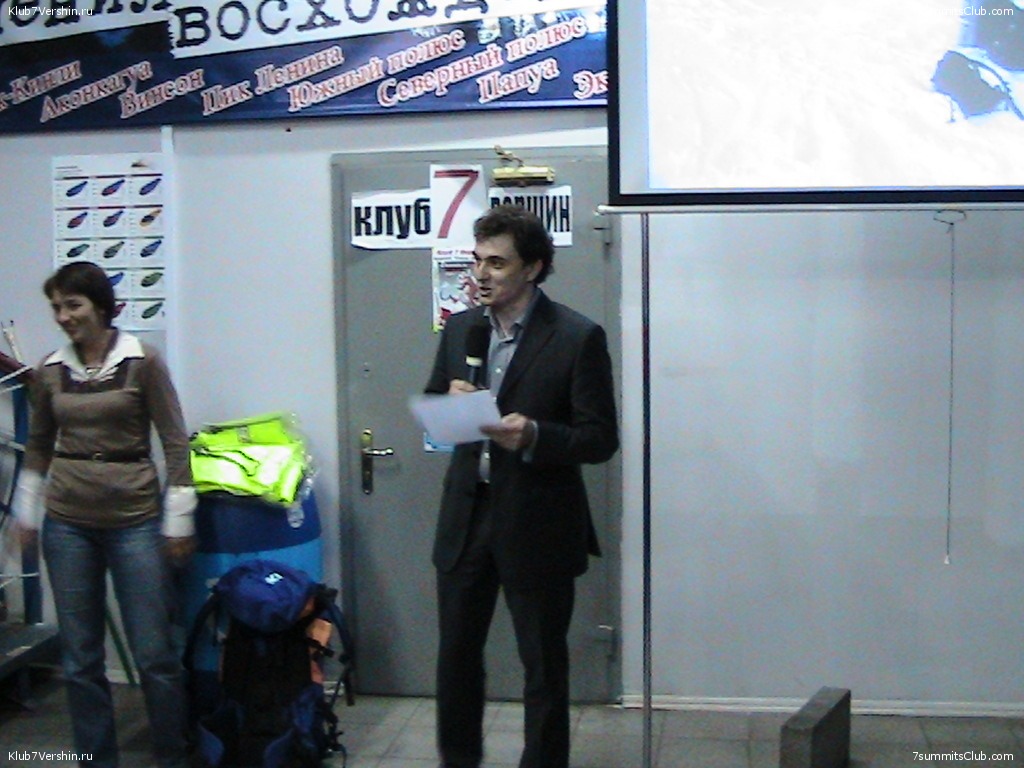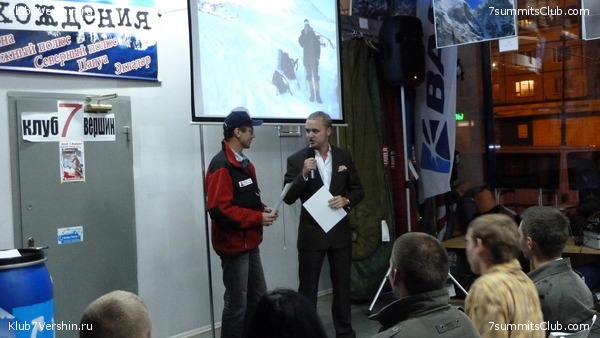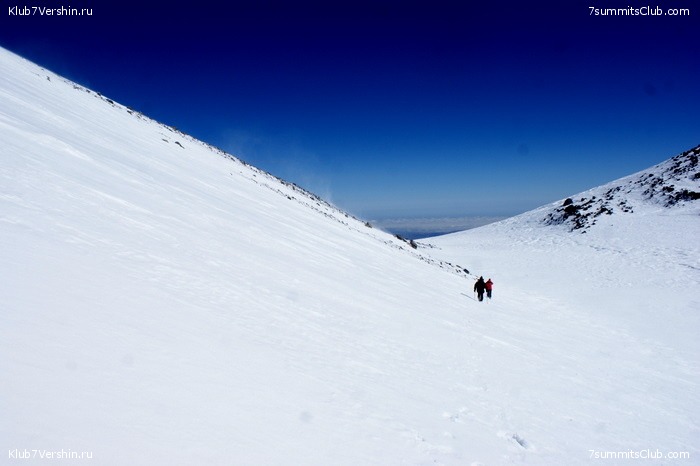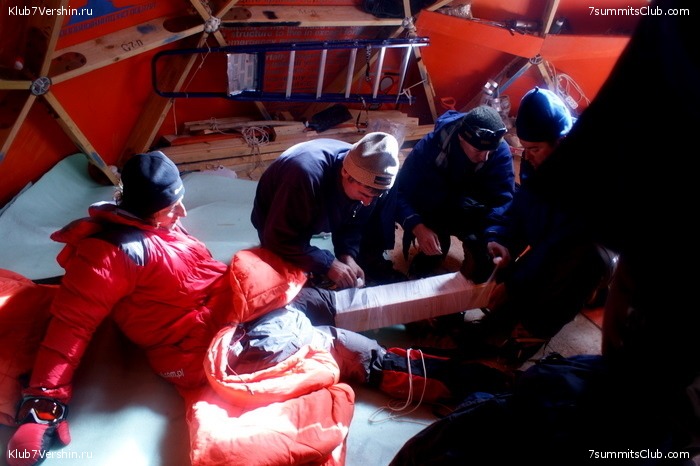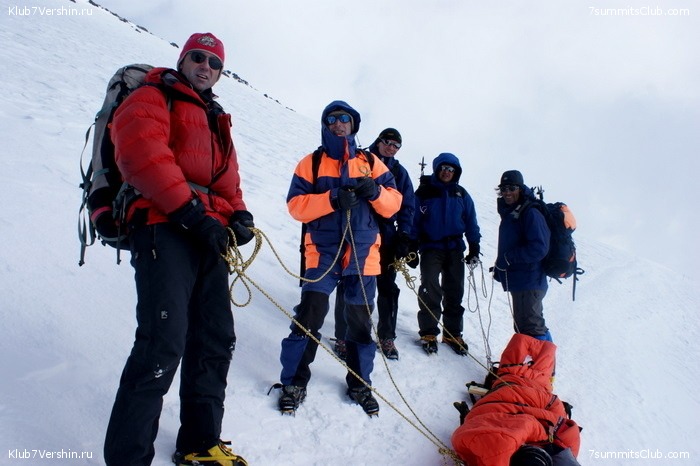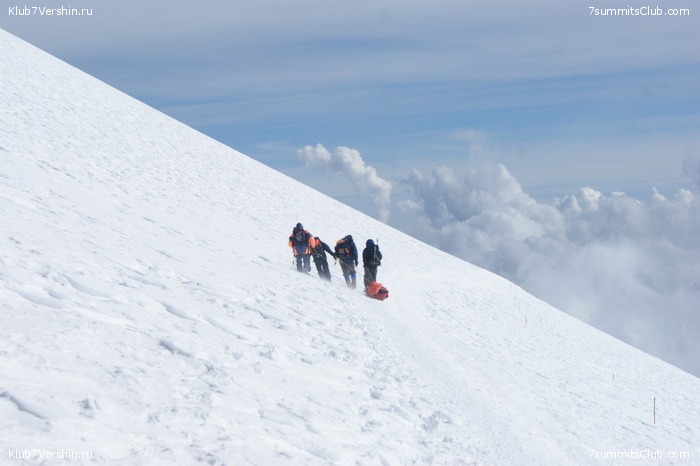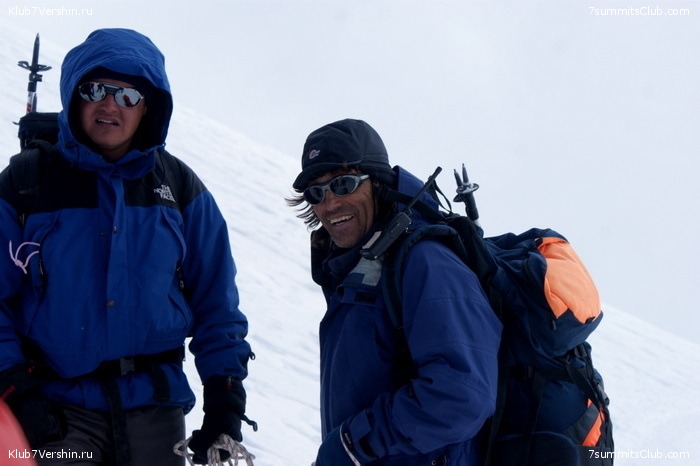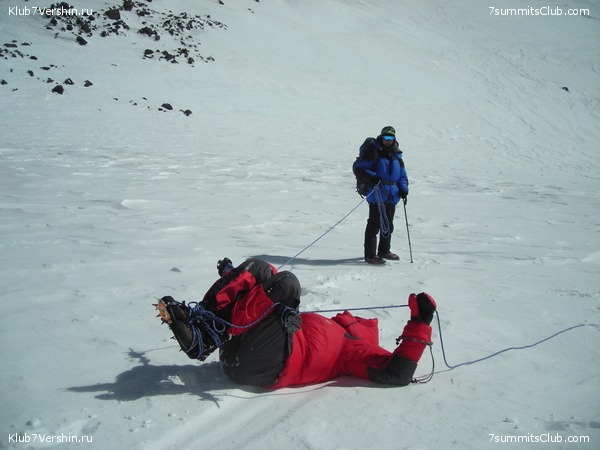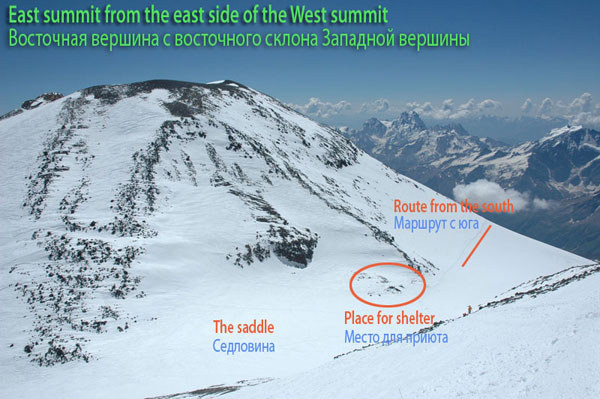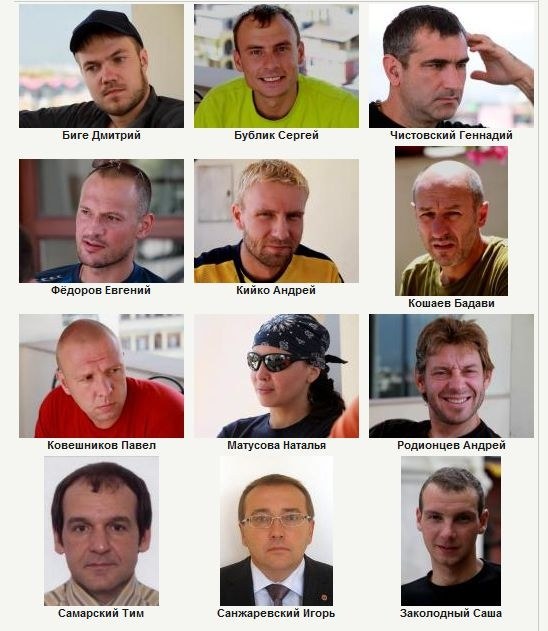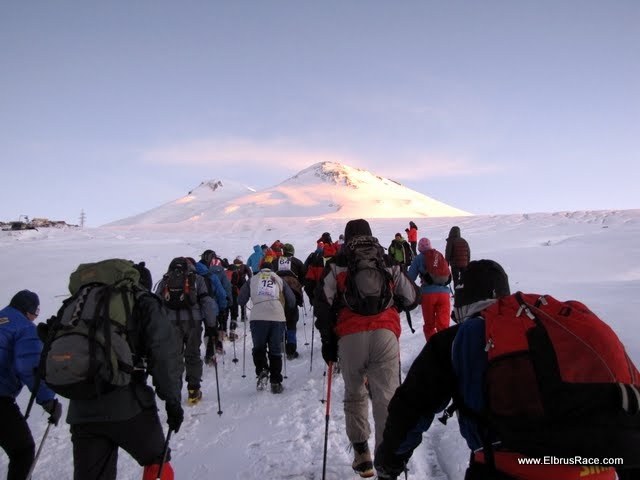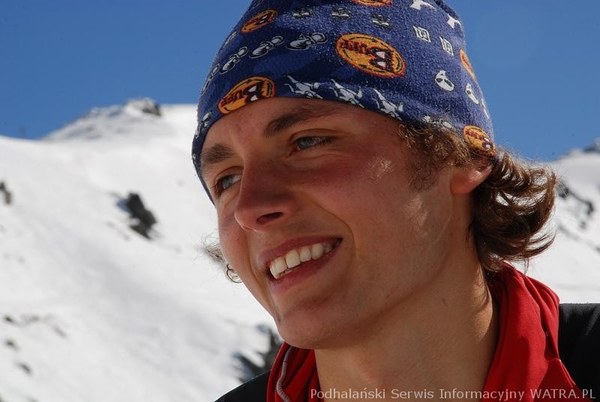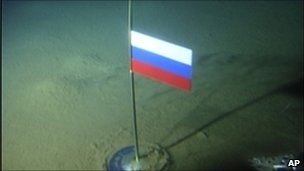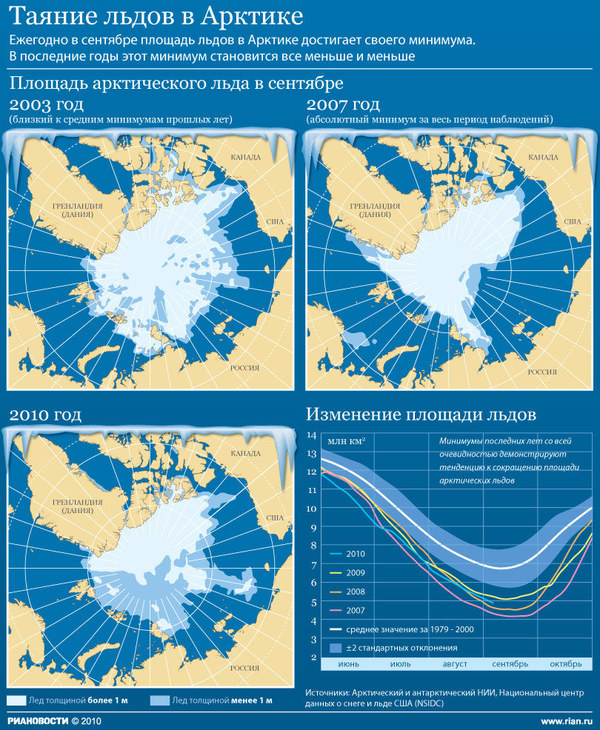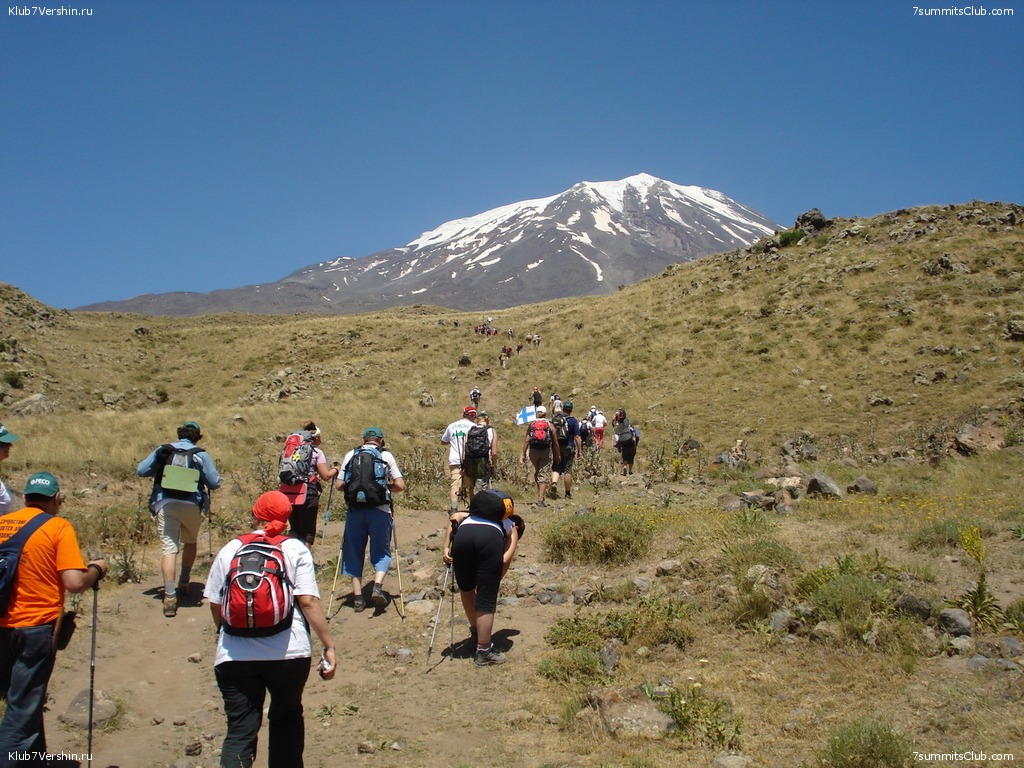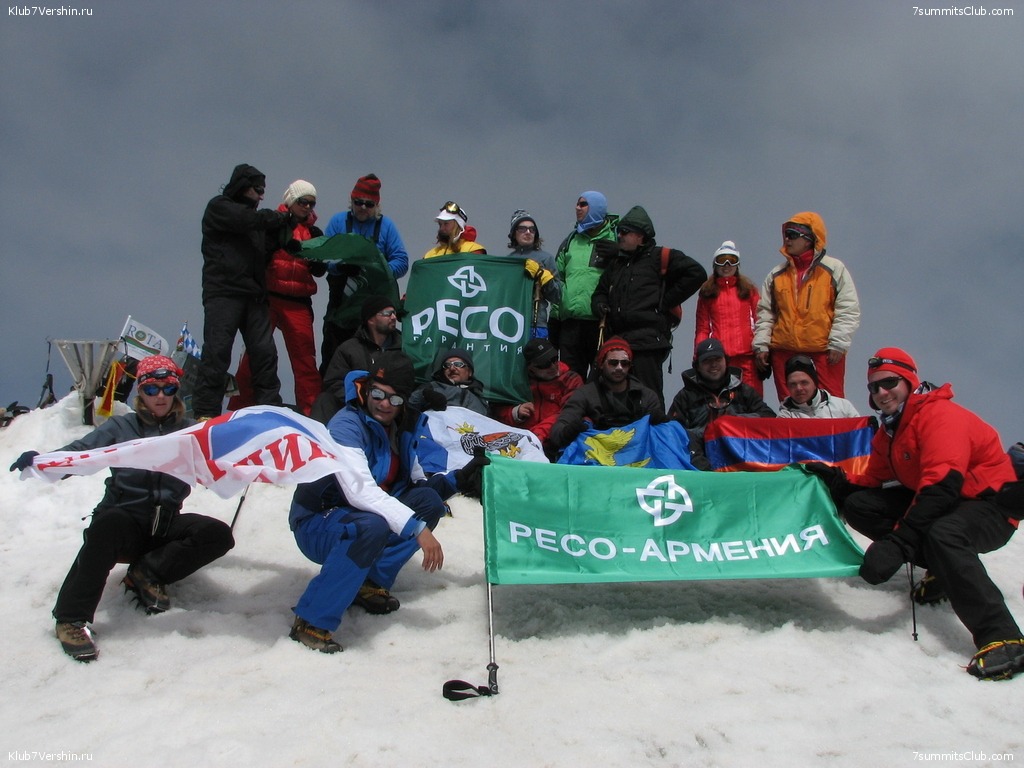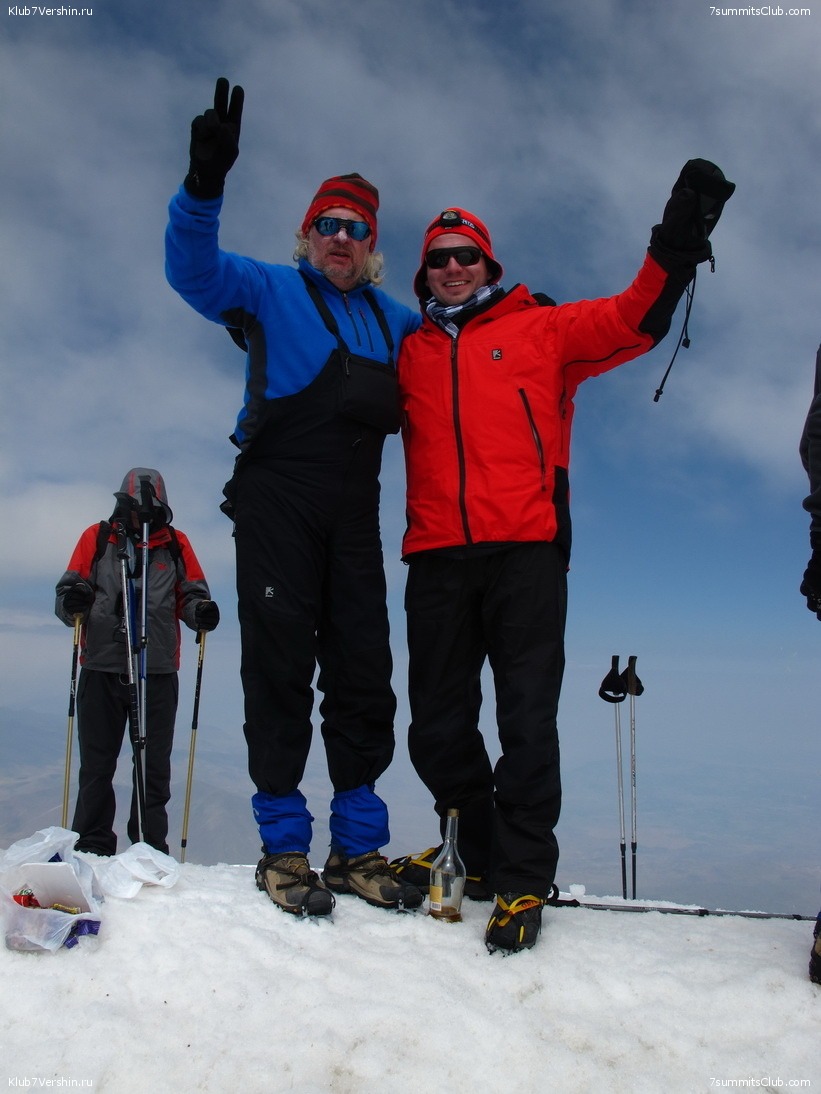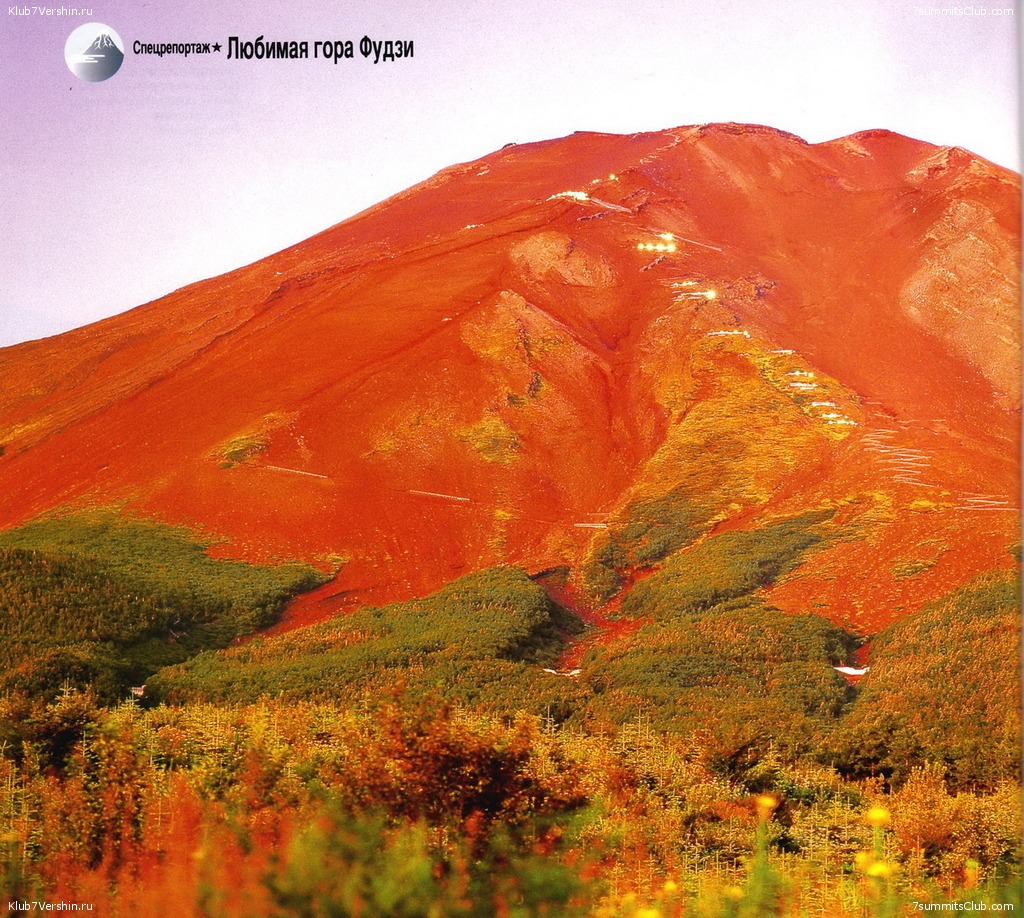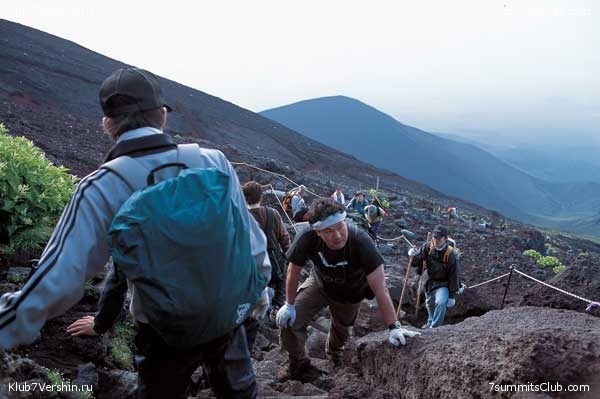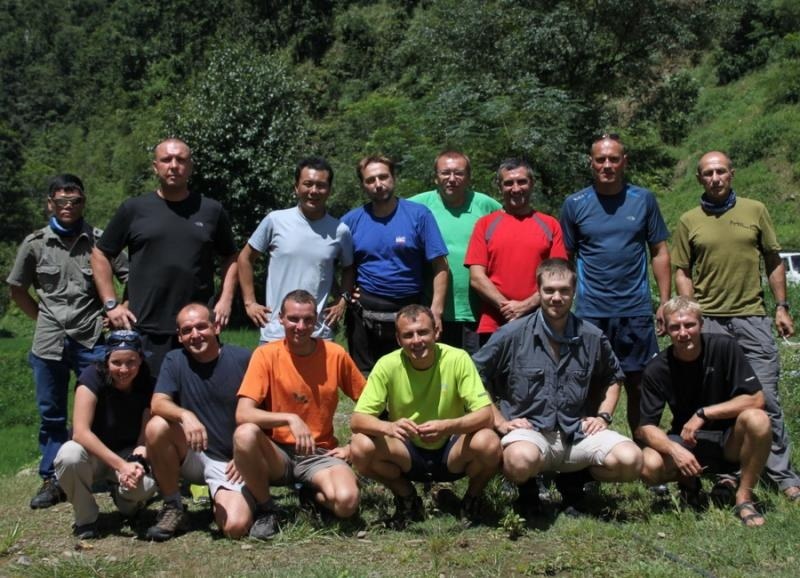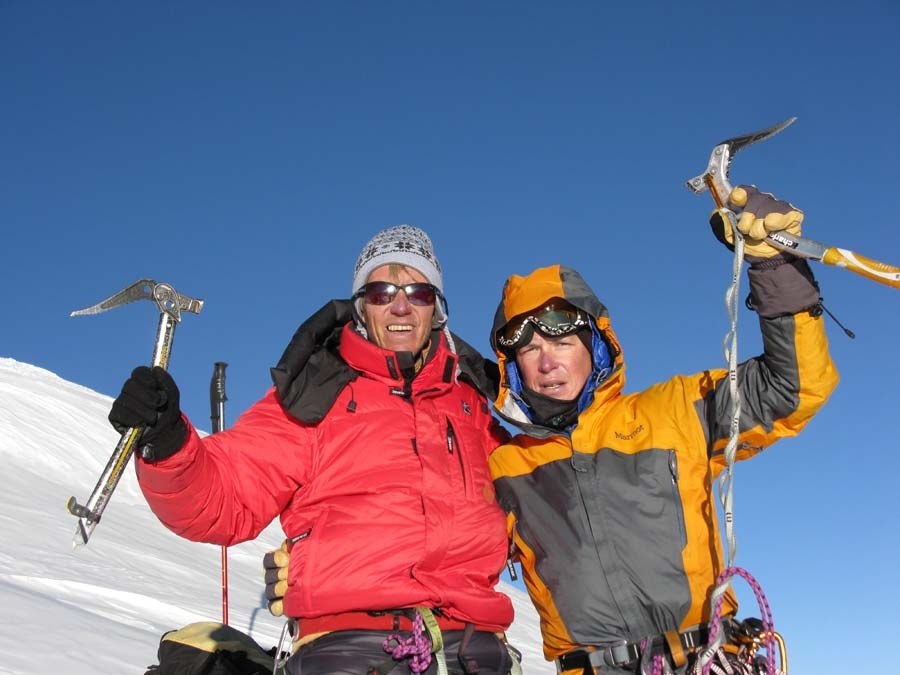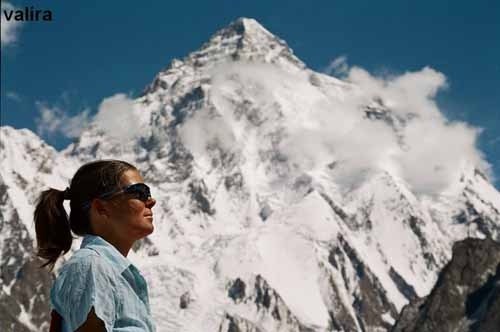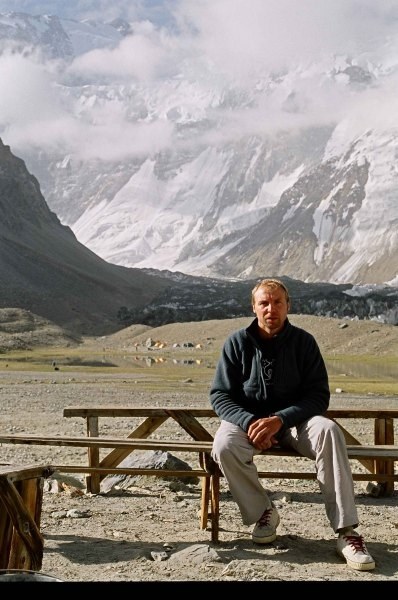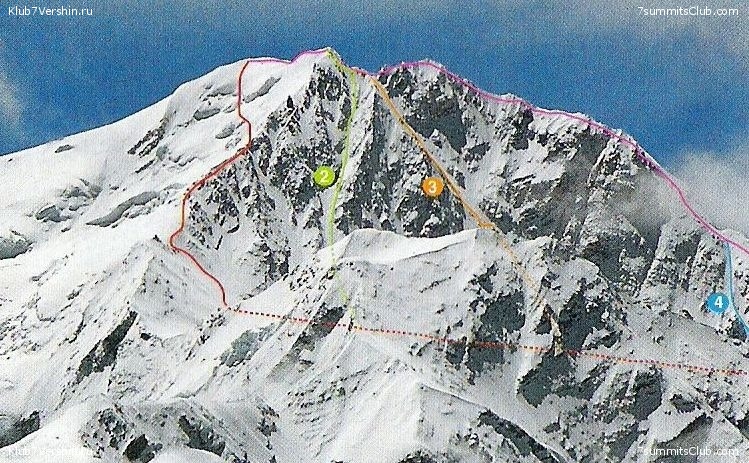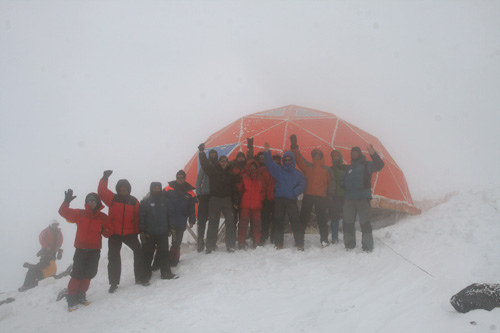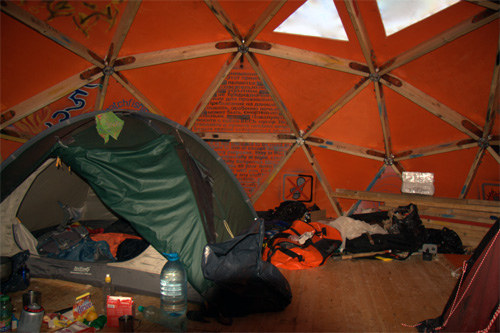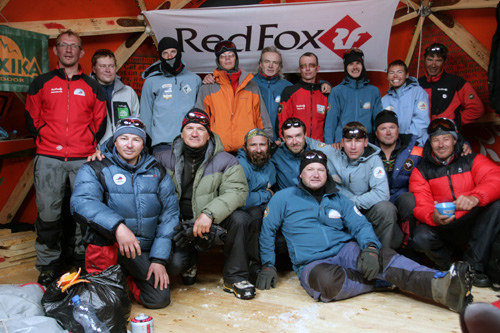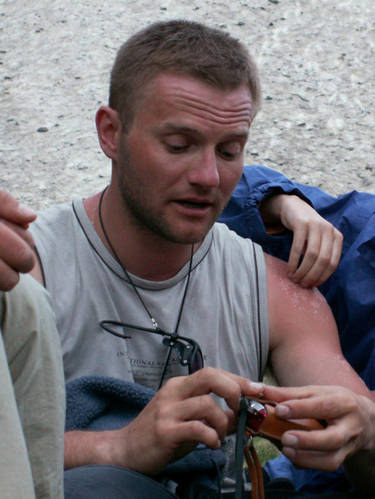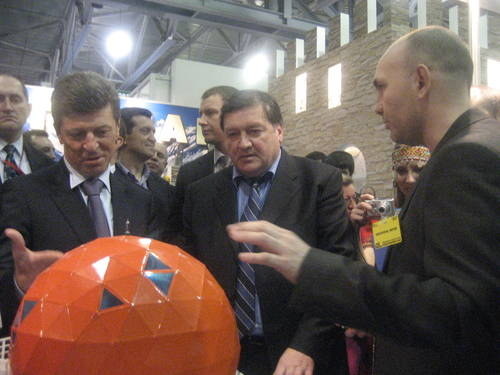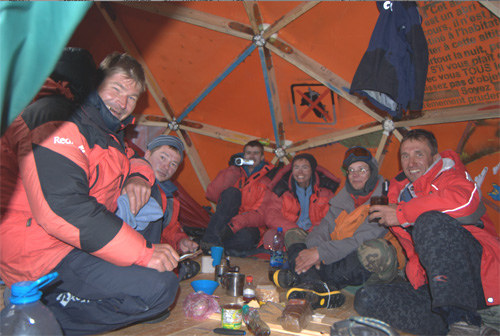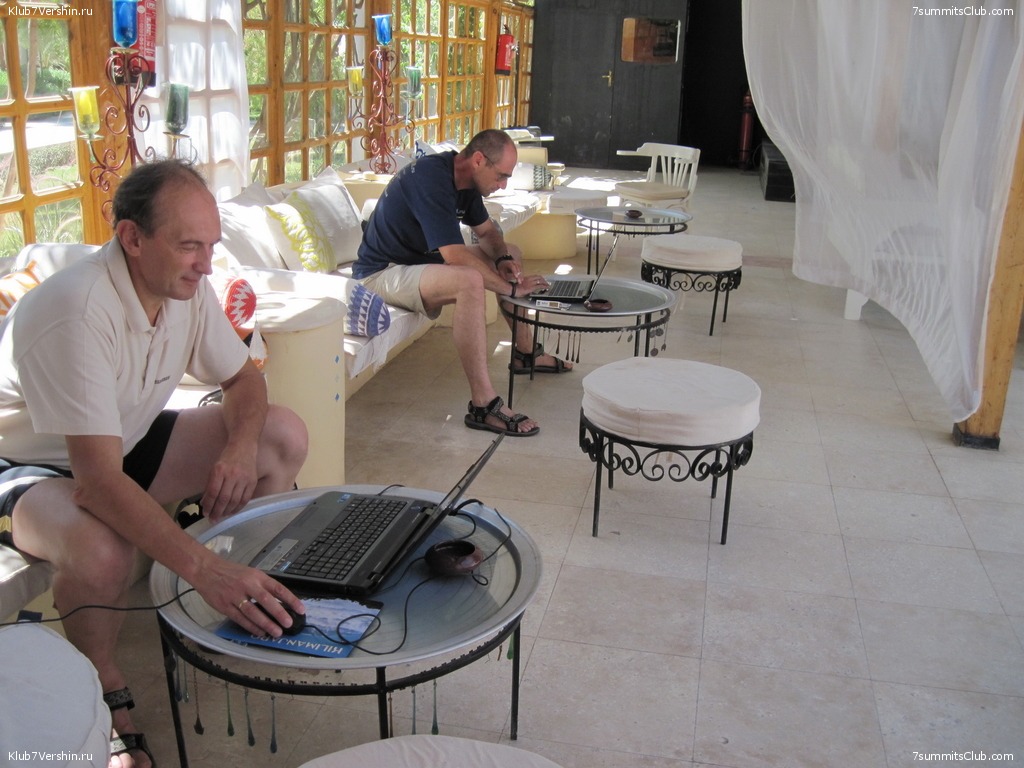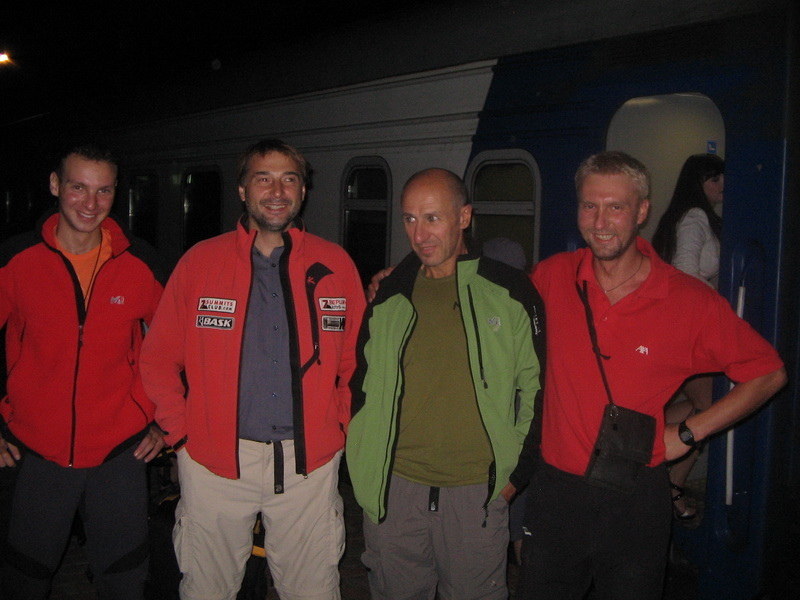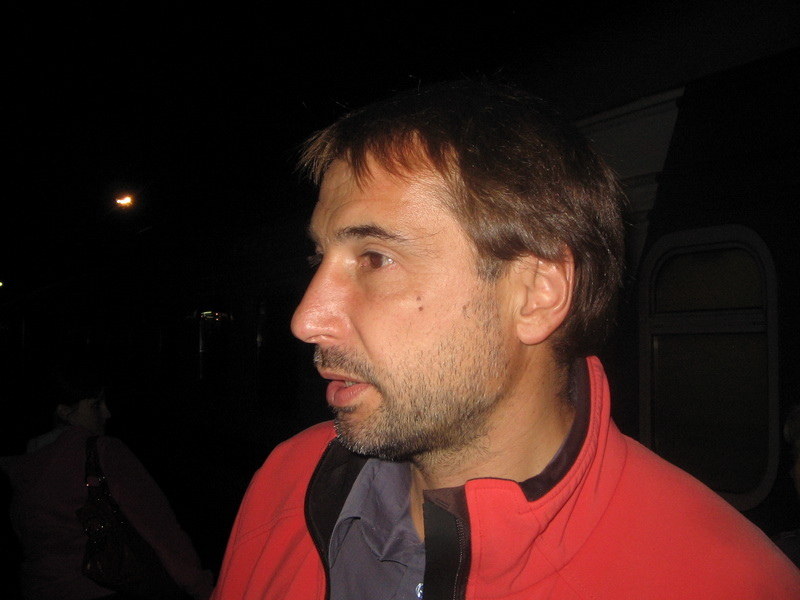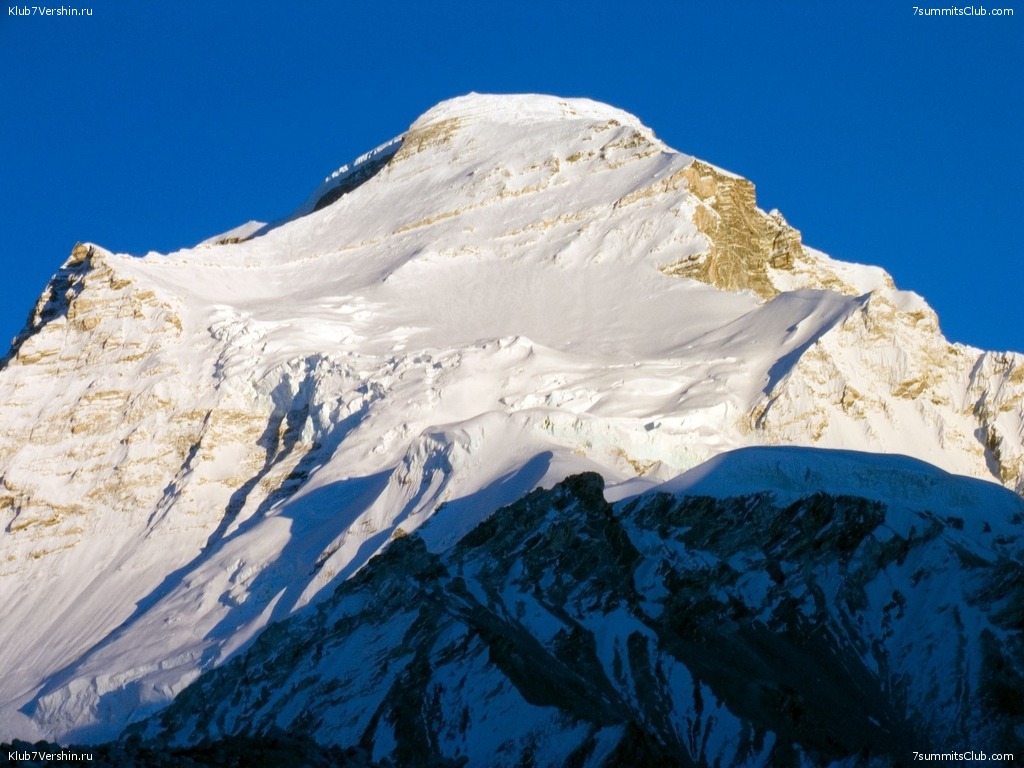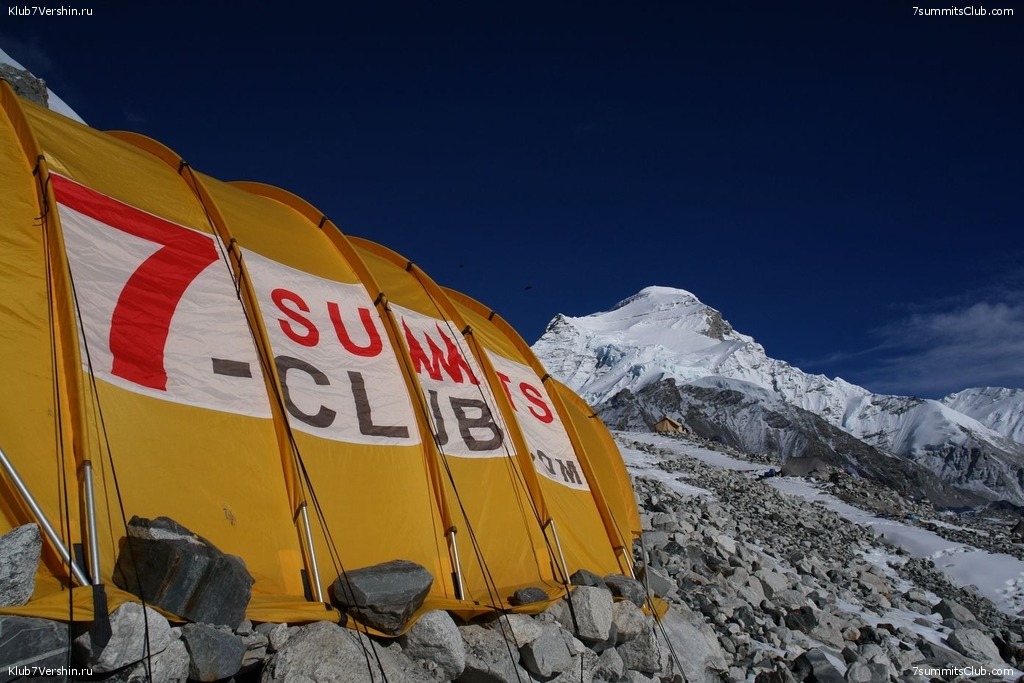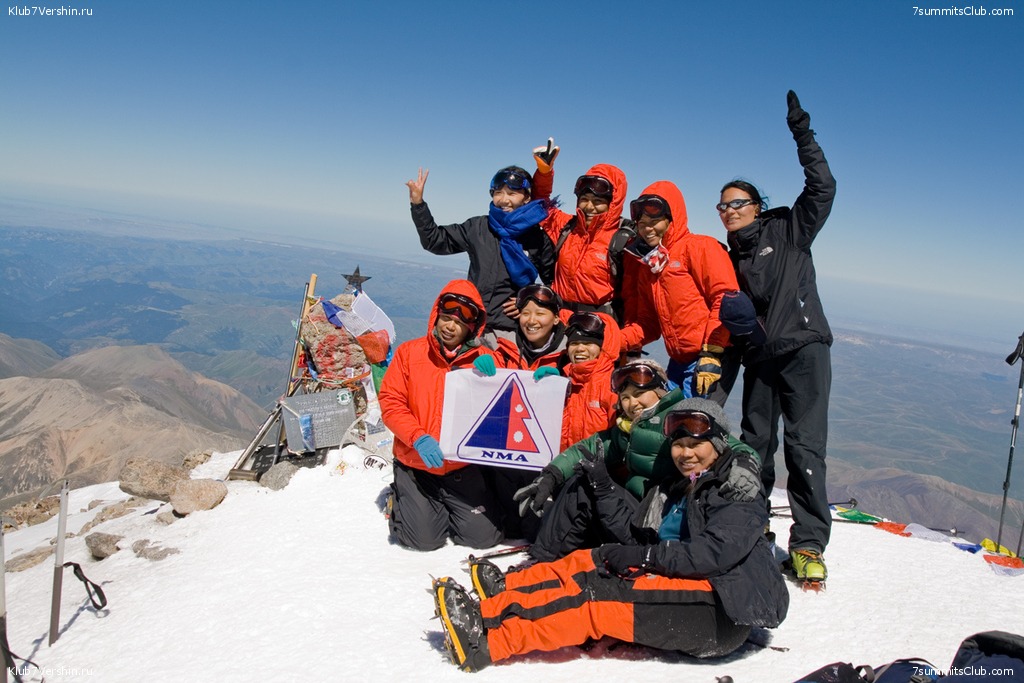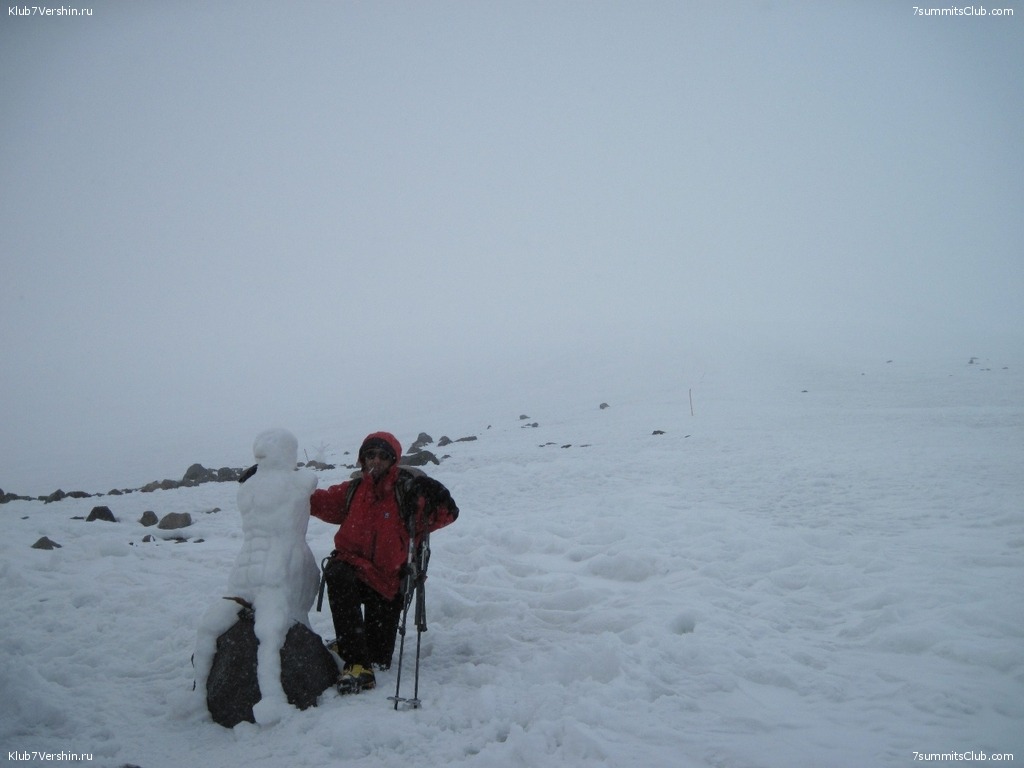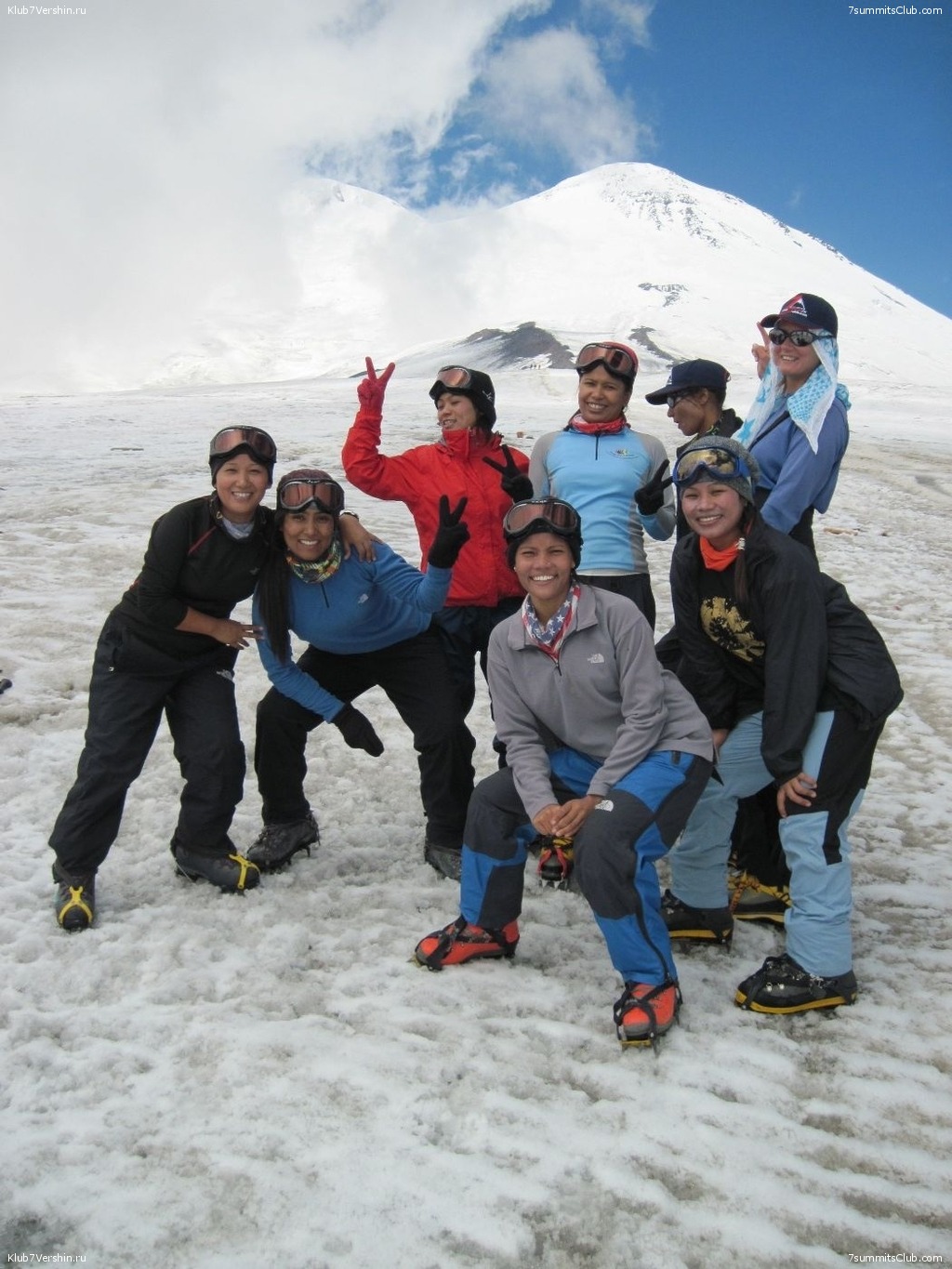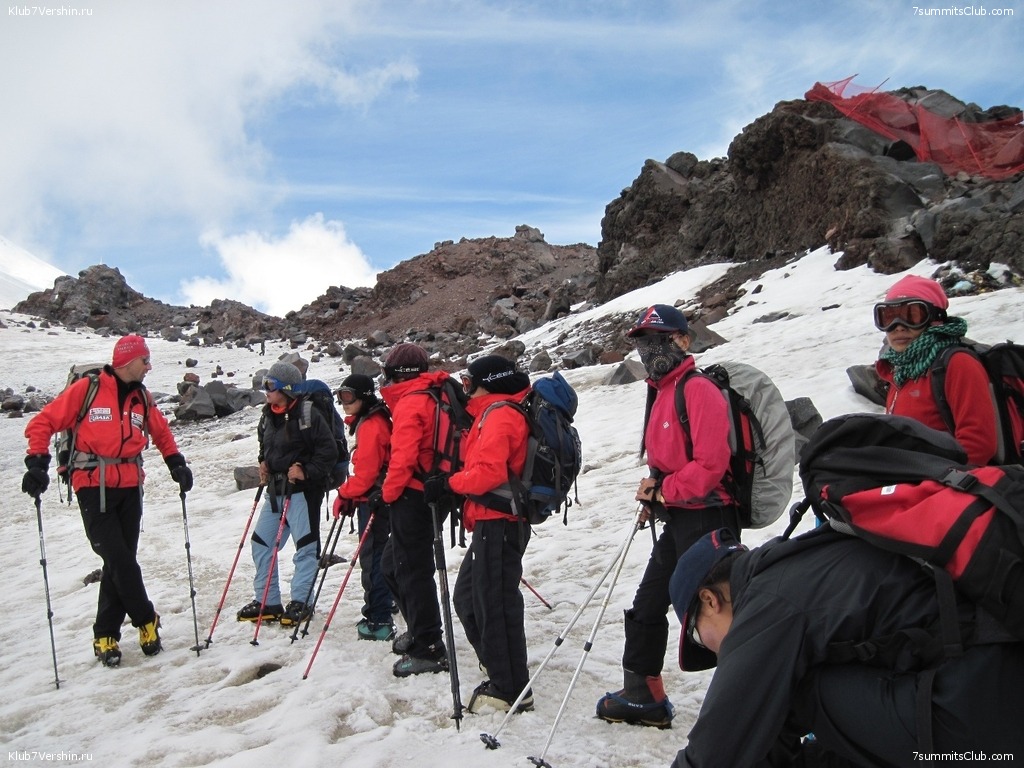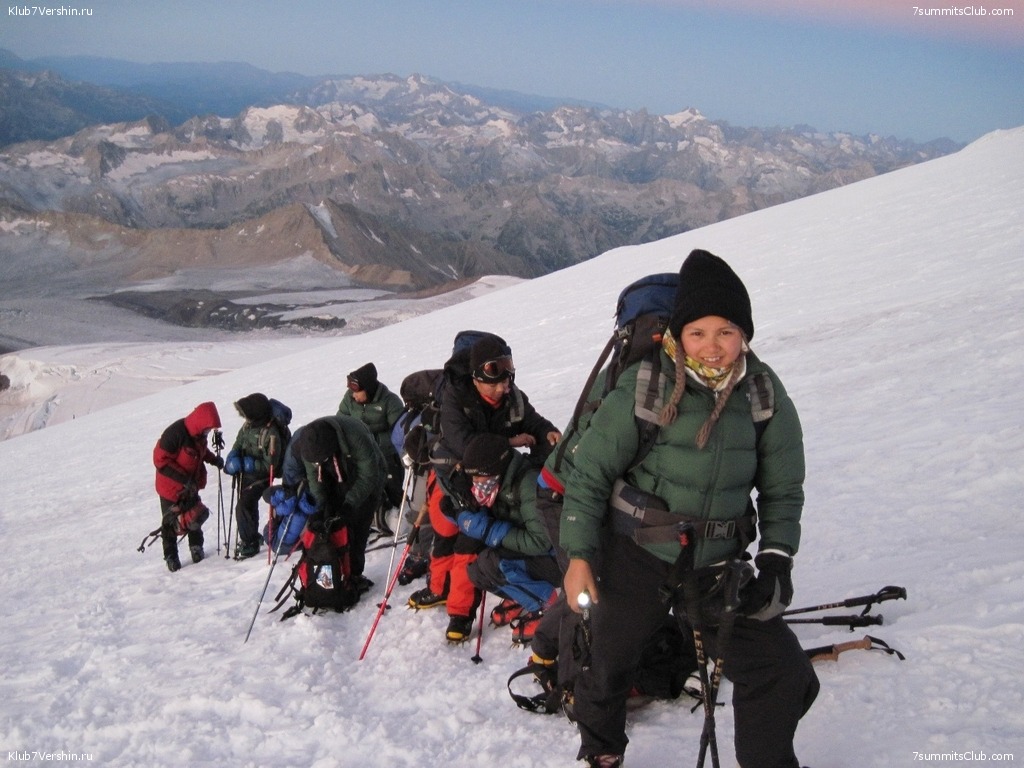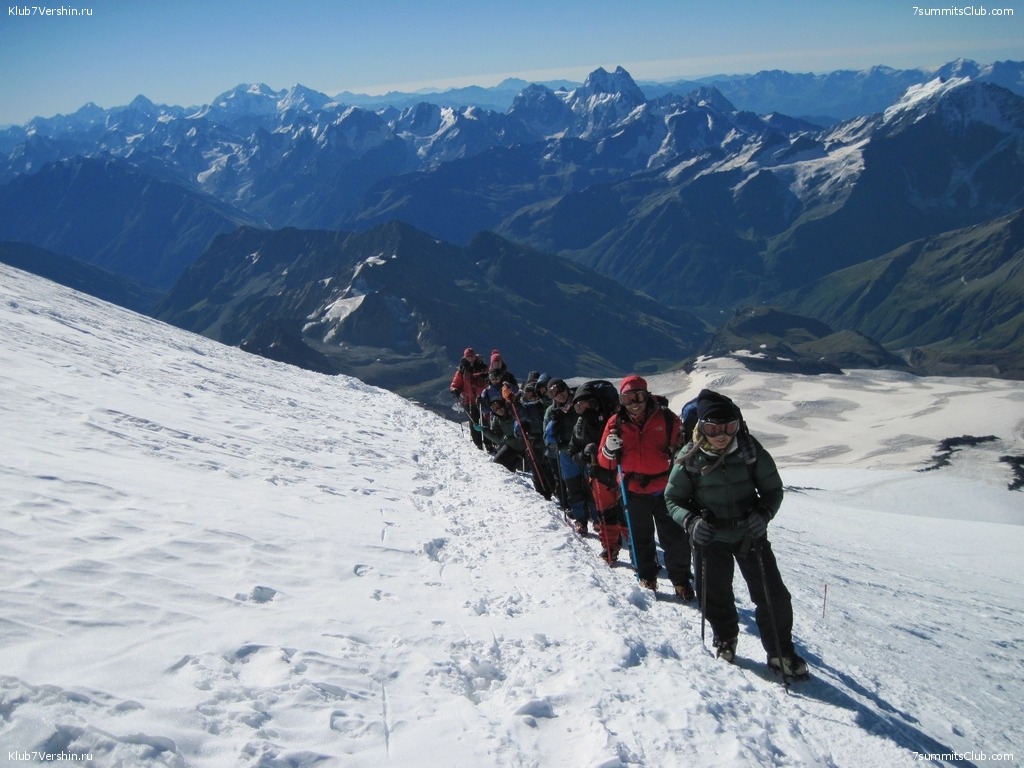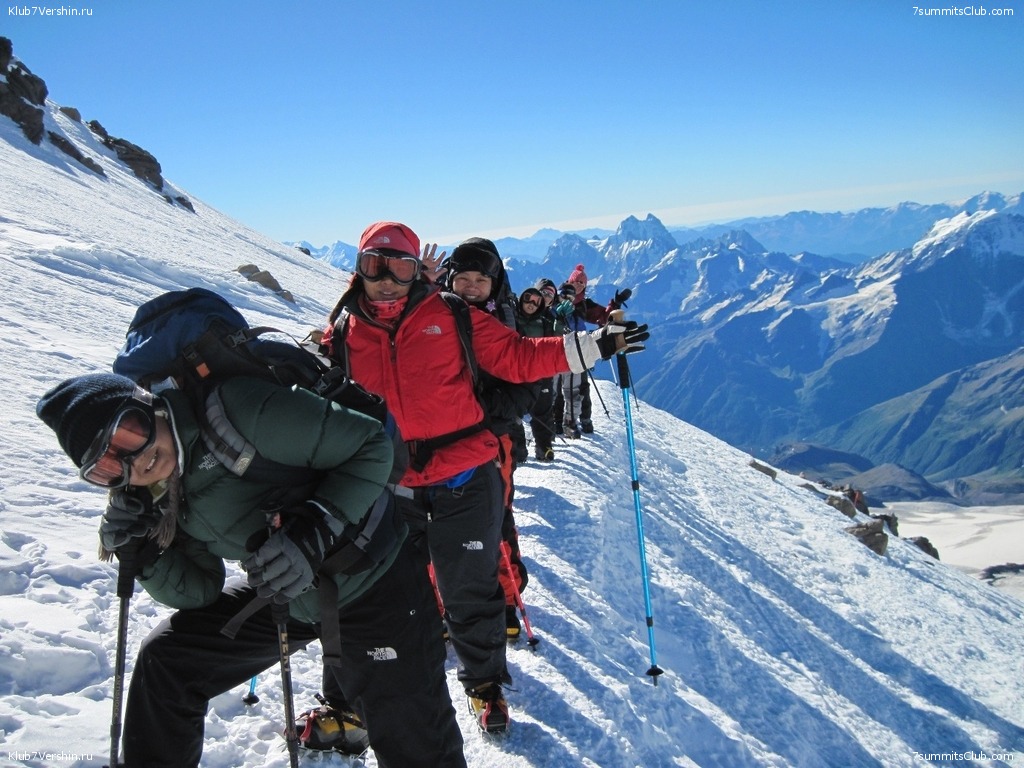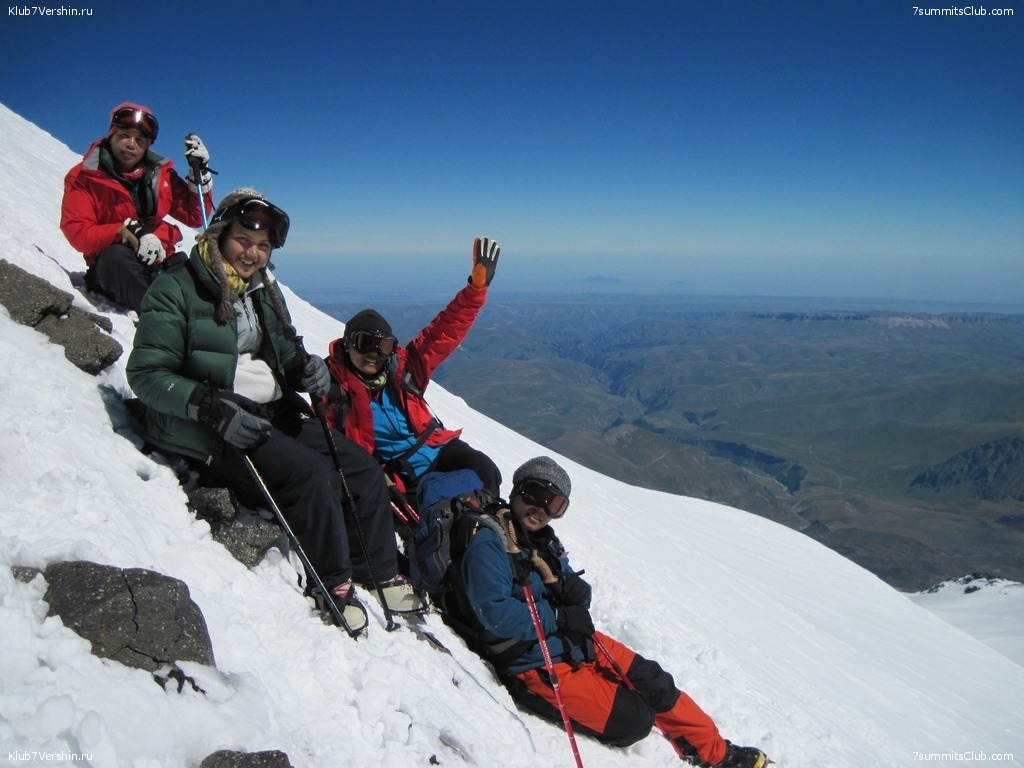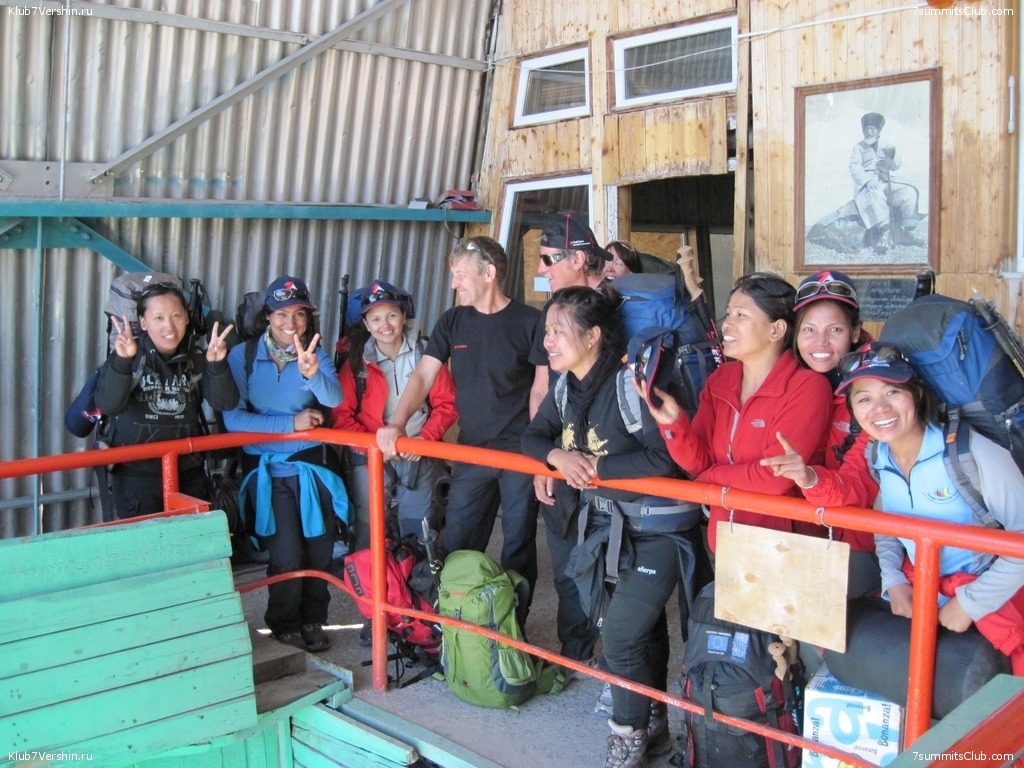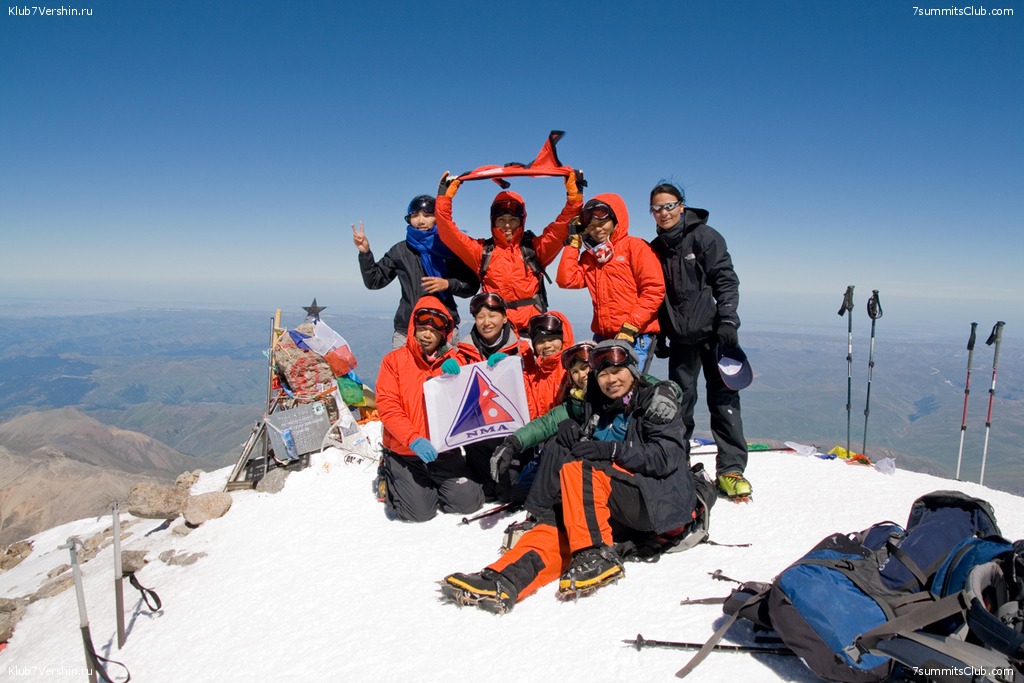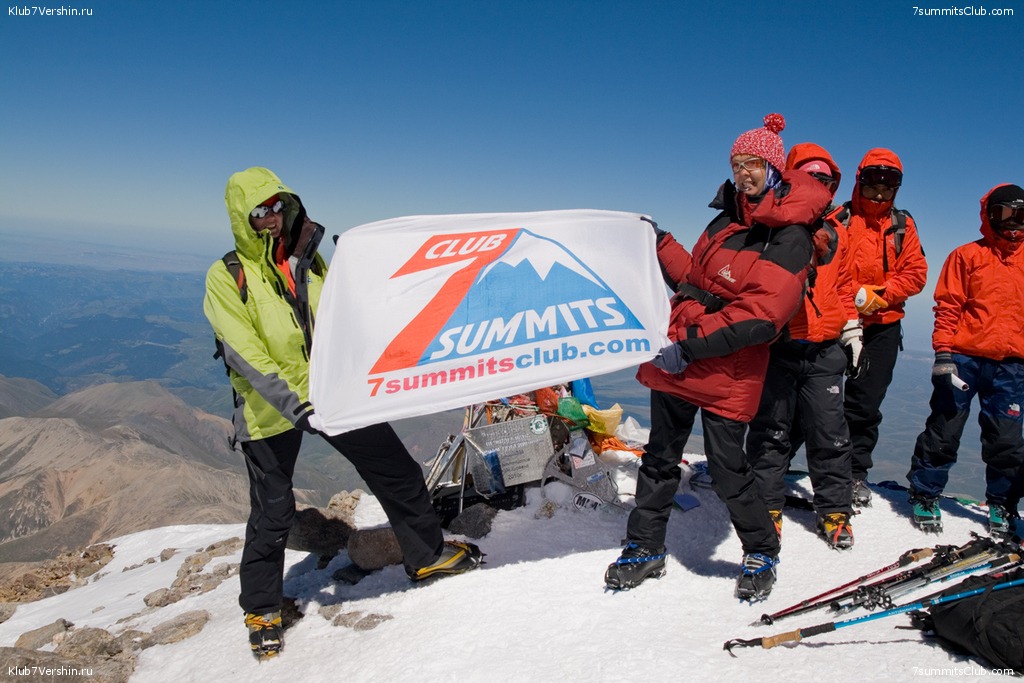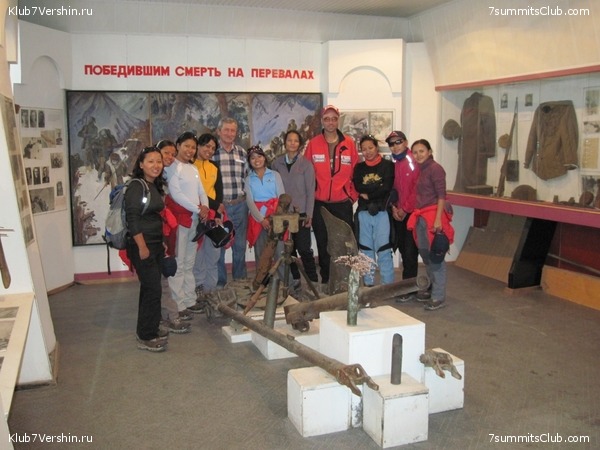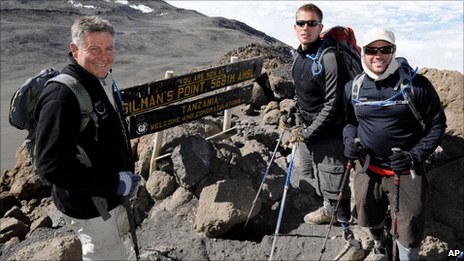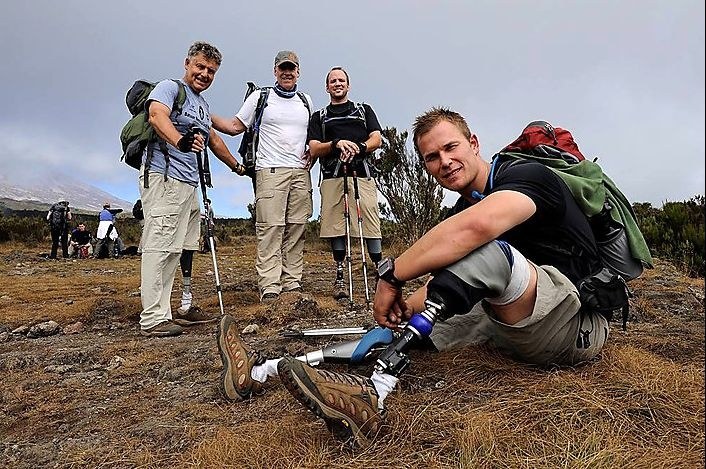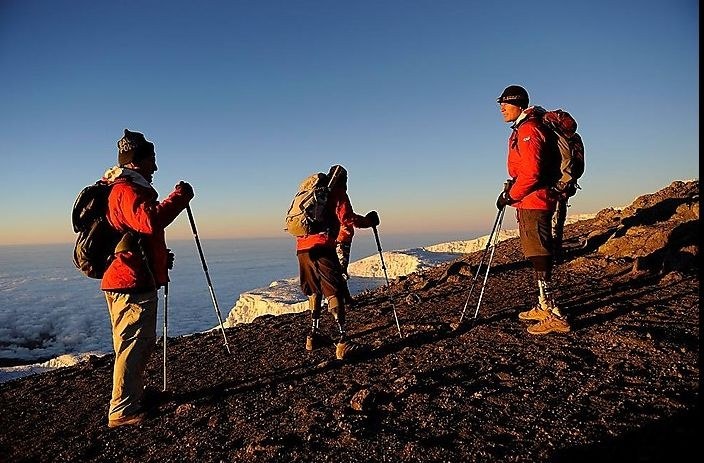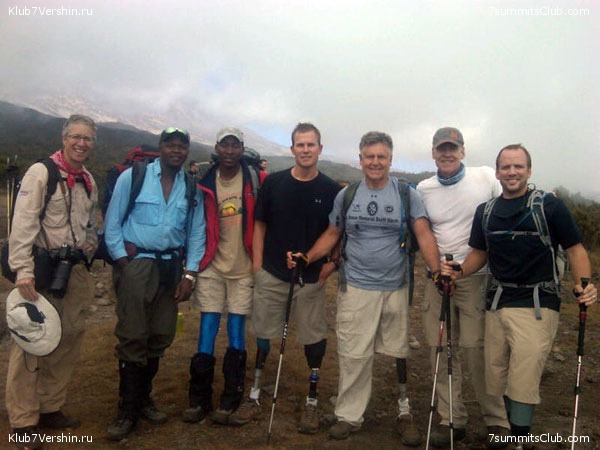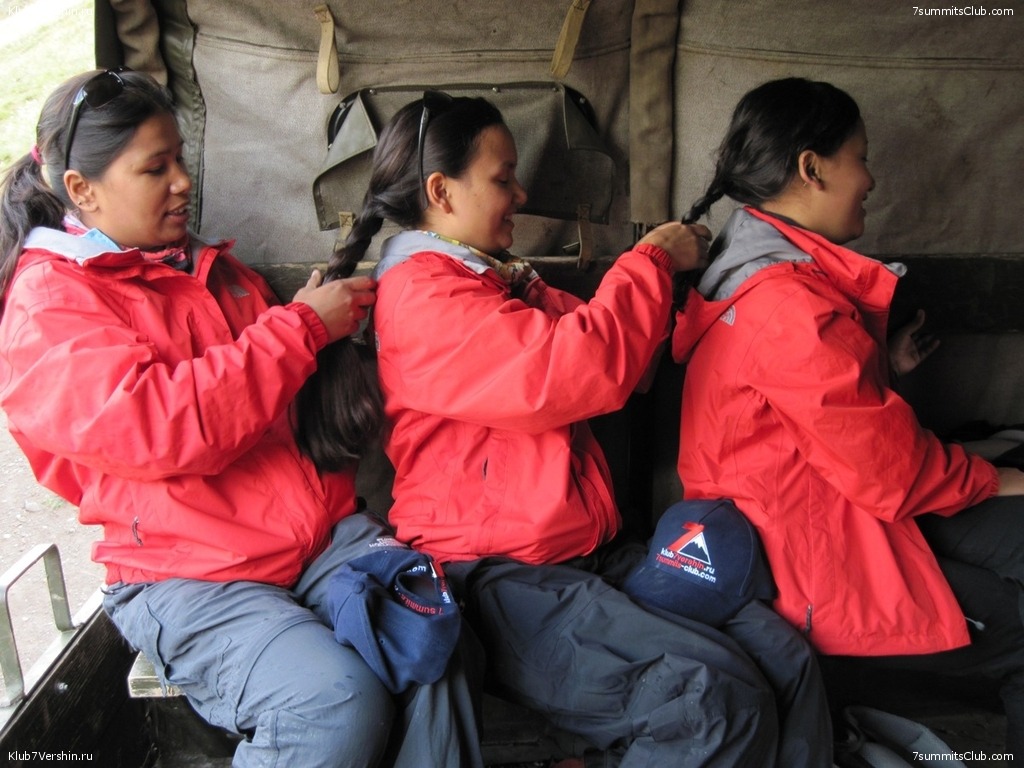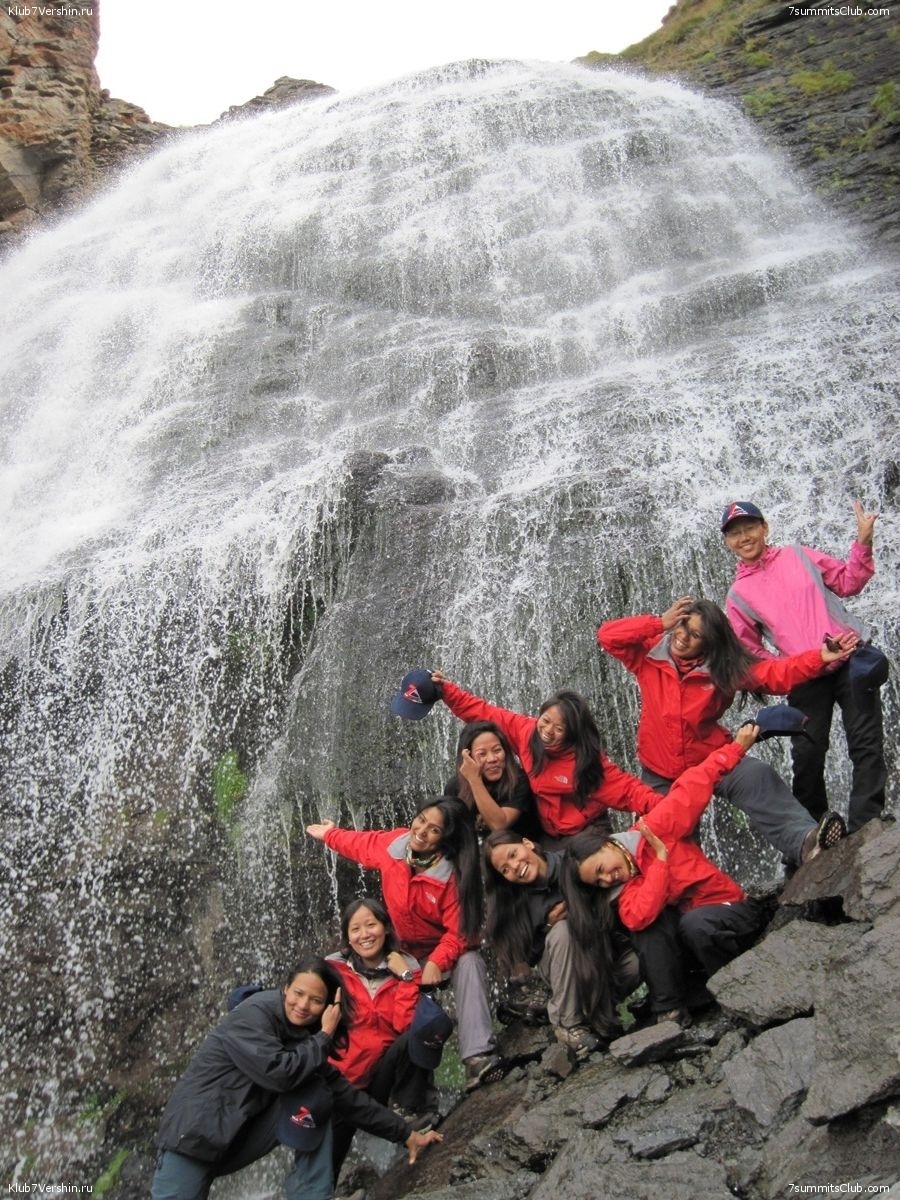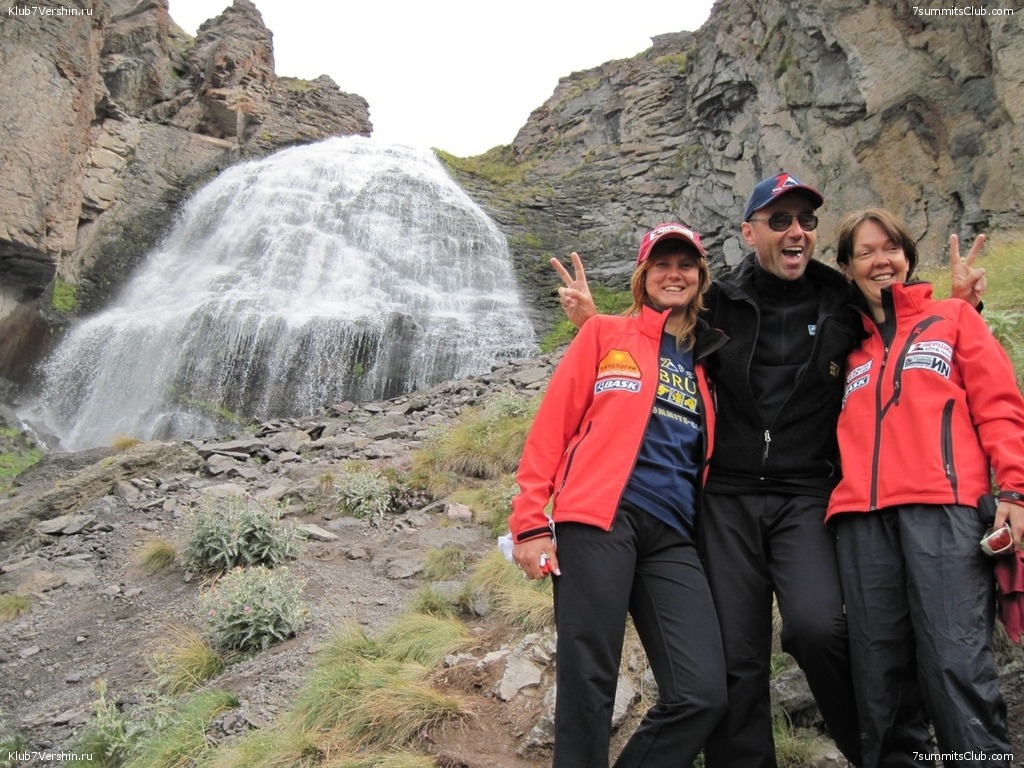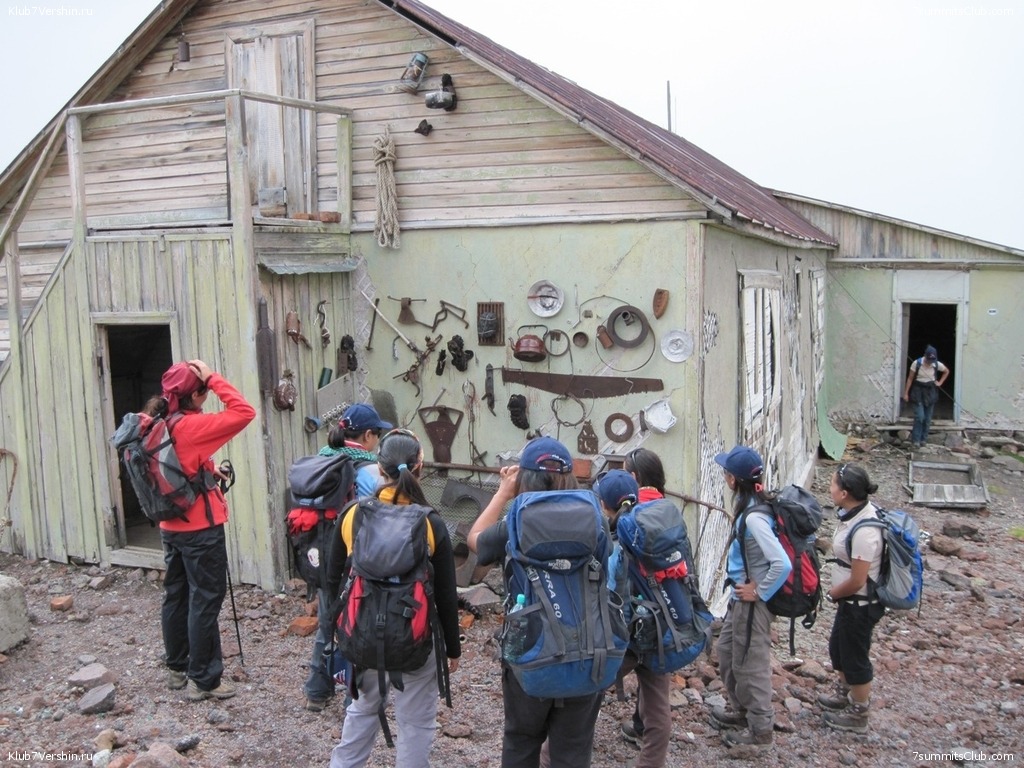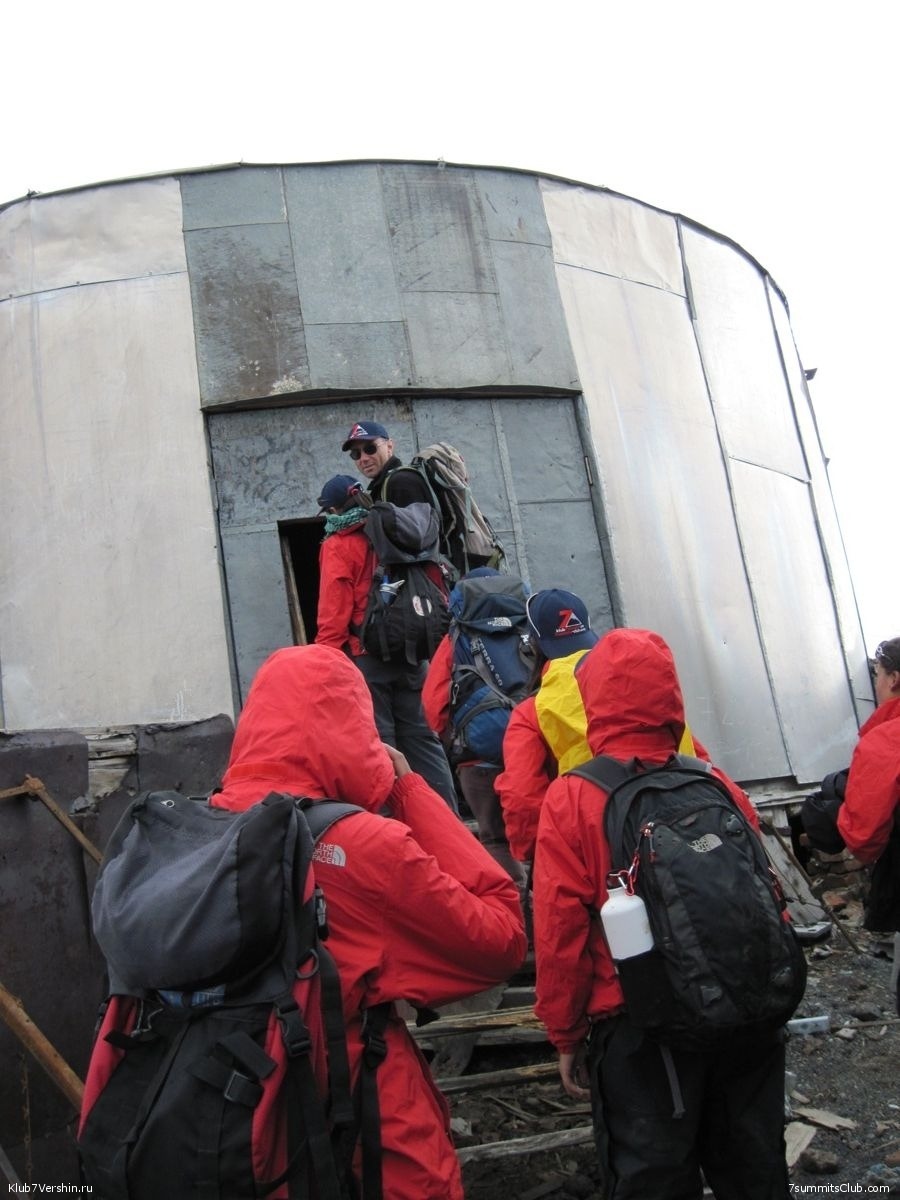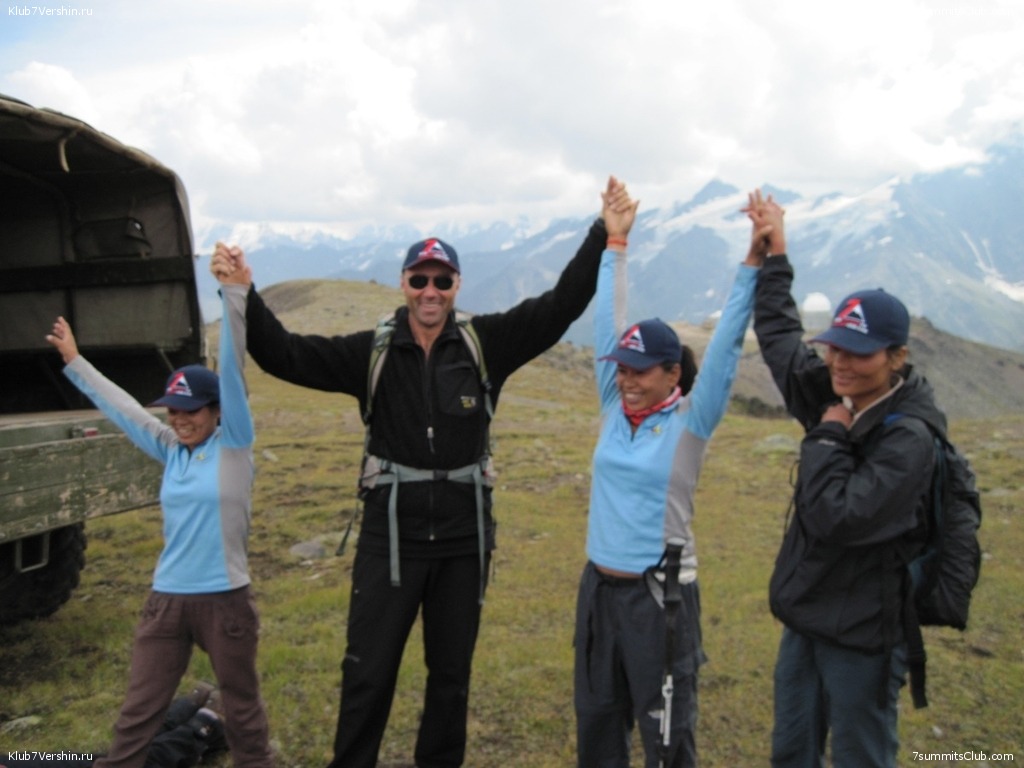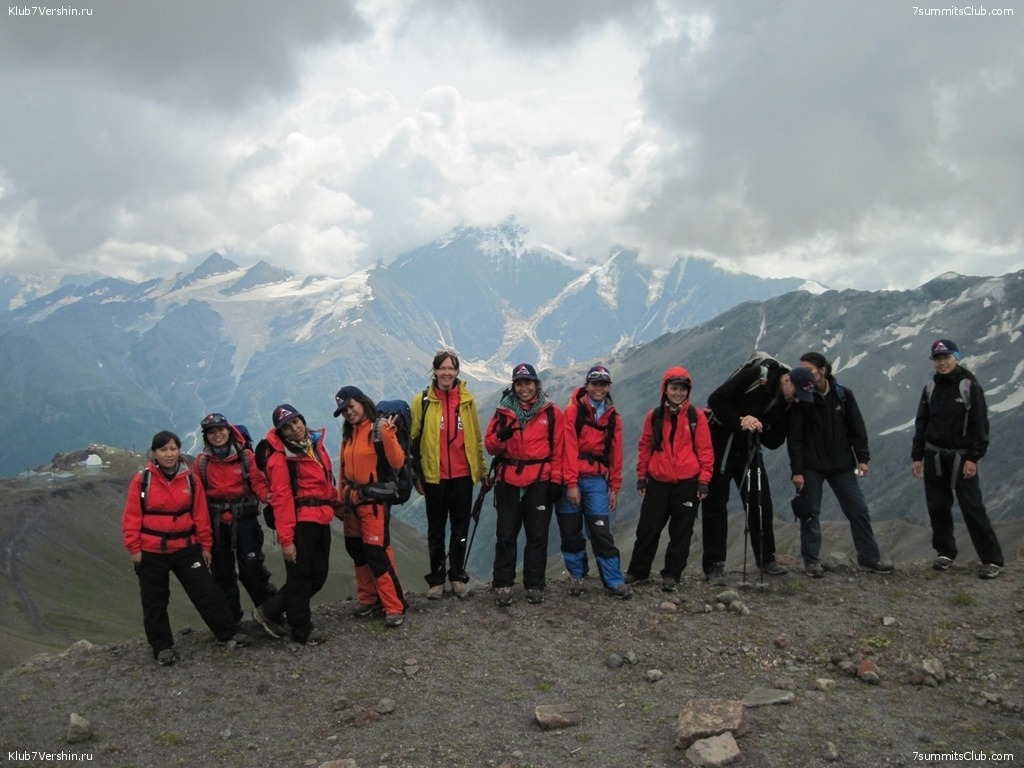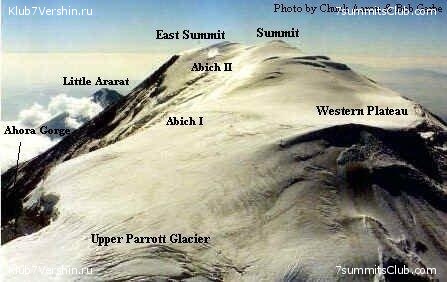All news
Evening party of 7 Summits Club was a great success
September, 30 we had a traditional evening meeting friends of 7 Summits Club. At this time, a record number of people came to hear reports on our expeditions. The famous mountain climber, winner of the Piolet d'Or Jury Koshelenko was the ...
September, 30 we had a traditional evening meeting friends of 7 Summits Club. At this time, a record number of people came to hear reports on our expeditions. The famous mountain climber, winner of the Piolet d'Or Jury Koshelenko was the chief guest. He spoke about his expeditions to Peru and the Pamirs. Then our guides were made with tales of his expeditions, we have shown films and pictures. Victor Bobok and Oleg Banar sang songs, we gave prizes for the best slogan for the club, played the lottery etc…
Photos from the party – full gallery is here >>>>>>>
Information from Cho-Oyu expedition
Cho-Oyu.
September 27, 17:10. Today, our group went up to Camp 2 at an altitude of 7,150 m. We have overcome heavy wind so the way took more than 7 hours. On the way, there was an ice wall and a few steep parts, which significantly delayed the temp ...
September 27, 17:10. Today, our group went up to Camp 2 at an altitude of 7,150 m. We have overcome heavy wind so the way took more than 7 hours. On the way, there was an ice wall and a few steep parts, which significantly delayed the temp of our group. Many groups came down to one "thread" on the fixed route, and we had to wait in line.
Quality of fixed ropes leaves much to be desired. The group of Tibetan climbers who have fix it did not return to base camp to continue operations.
Two Sherpas, who yesterday had stopped by a small avalanche, today tried to reach the summit. But they again got on top of a slope in an avalanche, which, fortunately, it was scattered along the slope, and no one caught. As a result, no one managed yet to reach the summit. But the way to the top now is almost trodden.
We have scheduled two nights at 7150m, then at 7500m and will be on the way back tomorrow. Descend to thr base camp: for rest and preparation for the main summit assault.
A group of Alexander Abramov rescued Polish climbers on Elbrus
Elbrus.
A group of climbers 7 Summits Club on Sept. 23 flew to the Caucasus, and had settled in the hotel Povorot in Terskol. September, 24 they made acclimatization outing up to the Pastukhov Rocks. September, 25 in the morning the team started ...
A group of climbers 7 Summits Club on Sept. 23 flew to the Caucasus, and had settled in the hotel Povorot in Terskol. September, 24 they made acclimatization outing up to the Pastukhov Rocks. September, 25 in the morning the team started the Elbrus climb. In the group were: Alexander Abramov (leader, guide and president of the 7 Summits Club), Sergei Onufrienko (guide), Ilya Shershnev, Dmitry Freiman, brothers Petr and Pavel Tolstykh.
At a good pace climbers went up from Pastukhov Rocks to the saddle of Elbrus (5300 m). However, here, on one of the Tolstykh brothers decided to turn back. Although, according to Abramov, he was in a good shape. Nevertheless, the two brothers and guide Onufrienko at 10:00 a.m. went down. Abramov, Shershnev and Freiman started climbing to the western summit (5642 m).
At about 10-30 a.m. they saw at a distance app. over one kilometer people who scream calling for help. Without hesitation, the group refused to continue climb and started to traverse to the victims. It turned out to be Polish climbers, young guy and girl. They slipped on descent from the summit and received multiple injuries when falling. The guy apparently had broken his leg and could not go by himself. Girl with a collarbone injury, minor injuries on hand and head could go. She was taken to a rescue hut on the another side of the saddle. The construction of this shelter was completed only on 1 September.
Unfortunately, the telephone and radio link on the saddle of Elbrus still does not work and to call for rescuers you need to go lower, about half hour. Except our group and Polish couple, only four climbers made the climb on this day. At 12:15 one of guides of the other group went down and called to the rescue services. The Polish girl and Dmitry Freiman left later down with Lisa Pahl, another Elbrus guide who was with a client. Alexander Abramov and Ilya Shershnev were stayed with the injured Polish climber. With great difficulty they dragged him to the hut. It takes about two hours of hard work. Approximately 3.30 p.m. four rescuers reached the hut, they provided medical assistance and at 4.00 p.m. started transportation. Approximately at 5.30 p.m. the group reached the Pastukhov Rocks, where a snowcat was waiting for them. The same evening, the Polish climbers were taken to hospital.
In the shelter
Alex Abramov - on the left and rescuers
Expedition Cho Oyu: Igor Svergun reported from 6400 m on the phone
Cho-Oyu.
September 25 - the first day when we can say that the weather is good. While none of the expeditions of unable to climb to Camp 3. Chinese "cooperative", which had to fix route has long gone down. Expeditions should make route joining ...
September 25 - the first day when we can say that the weather is good. While none of the expeditions of unable to climb to Camp 3. Chinese "cooperative", which had to fix route has long gone down. Expeditions should make route joining efforts.
Igor Svergun - leader of the expedition
 Our climbers Kijko - Zakolodny – Bublik reached the Camp 2 at 7150m altitude in the last outing and went down. After that, the way was blocked by snow. Two Sherpas, who tried to make a scheduled shipment, were crushed by the powdery snow on a steep section of the ridge. Fortunately, they managed to rescue themselves.
Our climbers Kijko - Zakolodny – Bublik reached the Camp 2 at 7150m altitude in the last outing and went down. After that, the way was blocked by snow. Two Sherpas, who tried to make a scheduled shipment, were crushed by the powdery snow on a steep section of the ridge. Fortunately, they managed to rescue themselves.
And now, today - September 26, our team finally got to Camp 1 at 6400m. Then we plan to reach a height of 7500m, with two overnight stays at 7150m.
All members are in good shape, not counting the usual maladies that accompany climbers - a cold, illness, throat, runny nose, cough ... But it all goes away as soon as putting on a backpack on your back.
Rodiontsev and Chistovsky intend to ski descent from 7500m. Today Rodiontsev tried to go off on a snowboard from a height of 6700m in an oxygen mask. Everything turned out. We hope that he will be able to descend on skis from the summit.
Members
Records on Elbrus, Polish climbers have reached a new level
Elbrus.
Records on Elbrus, Polish climbers have reached a new levelPress Release Competition Elbrus RaceSeptember, 24 International Elbrus Race competitions were held on the slopes of Mount Elbrus. Competitions in speed, sky running on the ...
Records on Elbrus, Polish climbers have reached a new level
Press Release Competition Elbrus Race
September, 24 International Elbrus Race competitions were held on the slopes of Mount Elbrus. Competitions in speed, sky running on the highest peak of Europe held sixth year in a row, starting in 2005. In September, when ice-snow conditions are better and when the number of climbers reduced.
Competitions are held in two classes. The first one is "Extreme": from the foot of mountain - Azau Glade (2400 m) to the highest point of Mount Elbrus - the Western Peak (5642 m). Route length is approximately 13 kilometers, vertical drop of more than 3000 meters. Anywhere in the world is no more competition on the track with such drop. A short track names "Classic". "Classic" starts from the refuge Barrels (3700 m) located at the upper cable car station Elbrus. The finish of this route is also on the western summit of Elbrus.
Two days before the main trial, athletes started in the classification race from Barrels to Pastukhov Rocks (4900m). The control time was two hours - this will be a "pass" on the main race.
A large group of experienced climbers, guides of Elbrus were on duty at the track up to the summit. They are capable of working at height for a long time, and can help athletes in case of changing weather conditions.
This year's Elbrus Race was attended by athletes from Russia, Ukraine, Kazakhstan, Azerbaijan, Poland, USA and Indonesia. The Polish team was led by well-known mountaineer, Himalayan climber Artur Hajzer. It was a group of young, well trained and motivated athletes. Artur wants to build a new national team, capable to continue traditions of Polish Himalayan mountaineering. Hajzer regards Elbrus Race as a good possibility of endurance testing for athletes.
Young Polish ski-alpinist, mountain guide from Zakopane Andrzej Bargiel (22 years old) became a champion on "Extreme" class, with a phenomenal time - 3 hours 23 min 37 sek. He managed to improve the previous record set by Denis Urubko in 2006 (3 h 55 m 59 s) more than on half of hour. 28-years old “snow leopard” Alexandra Dzik from Poland was first in women contest with record time - 5 hours 4 minutes 41 seconds!
On the track "Classic" Andrey Puchinin from Kazakhstan came to the finish line first (2 hours 34 minutes 33 seconds), improving his own result in 2006 almost on 12 minutes! Russian Oksana Stefanishina (Sochi) won the race in the class of "Classic" for women. Her time was 3 hours 22 min 01 sec.
Particularly we should note a veteran Boris Korshunov, who on Aug. 31 was 75 years old. His result on the Classic track was 4 hours 16 minutes - 14 th place.
Elbrus - it's not a treadmill. There are factors inherent in the high mountains, for example, a strong wind. In calm weather the result of all athletes would be higher. This year's judges were forced to postpone the race start from September 23 to September 24 because on the mountain was very bad weather.
For the sixth time the Top Sport Travel company (www.sklon.ru) and news server www.Russianclimb.com organize competitions International Elbrus Race.
NPF Bask is the third time became the general sponsor of the international competitions.
Mountaineering Federation of Azerbaijan - General Partner VI International Elbrus Race.
Sponsors of the competition:
Company SIVERA (Ryazan)
Shop "Tramontana" (St. Petersburg)
The memorial fund Anatoly Boukreev (USA)
Official website of the competition www.Elbrusrace.com
Arctic summit in Moscow hears rival claims
North Pole.
Russia made its ambitions clear by planting a flag beneath the North Pole. An international meeting to try to prevent the Arctic becoming the next battleground over mineral wealth is taking place in Moscow. One quarter of the world's ...
Russia made its ambitions clear by planting a flag beneath the North Pole. An international meeting to try to prevent the Arctic becoming the next battleground over mineral wealth is taking place in Moscow. One quarter of the world's resources of oil and gas are believed to lie beneath the Arctic Ocean. Russia, Norway, Canada, Denmark and the United States have already laid claim to territory in the region.
Although the summit is promoting dialogue, a Kremlin adviser said Russia would defend its national interests.
Senior Norwegian adviser Olaf Orpheum told the conference that nowhere else had seen "such dramatic changes in the surface of the Earth".
The race for the Arctic centres on an underwater mountain range known as the Lomonosov Ridge.
In 2001, Moscow submitted a territorial claim to the United Nations which was rejected because of lack of evidence.
Three years ago, a Russian expedition planted a titanium flag on the ocean floor beneath the North Pole in a symbolic gesture of Moscow's ambitions.
Law of the Sea
As evidence of the gathering momentum in the race for mineral resources, Russia has announced it will spend $64m (£40m; 48m euros) on research aimed at proving its case.
The man behind the 2007 polar expedition, Artur Chilingarov, has announced that he will attempt to launch a drifting research station next month.
Kremlin climate change adviser Alexander Bedritsky told reporters that Russia had a "strong chance" to win approval when it submitted its data to the UN in 2012-13.
Last week, Canada's foreign minister met his Russian counterpart in Moscow to discuss their competing claims.
Canada is likely to hand its file to the UN around 2013 and has said it is confident of its case.
Denmark plans to put forward its details by the end of 2014.
For the states involved in the territorial dispute, the key lies in obtaining scientific proof that the Lomonosov Ridge is an underwater extension of their continental shelf.
Under the UN Convention on the Law of the Sea, a coastal nation can claim exclusive economic rights to natural resources on or beneath the sea floor up to 200 nautical miles (370km) beyond their land territory.
But if the continental shelf extends beyond that distance, the country must provide evidence to a UN commission which will then make recommendations about establishing an outer limit.
Last week, Russia signed a treaty with Norway, ending a 40-year dispute over their maritime borders in the Barents Sea and Arctic Ocean.
Russian Arctic expert Lev Voronkov said the experience of the Cold War proved the need to work together.
"No one problem of contemporary Arctic can be resolved by one country alone. So that's why I think that we are doomed to co-operate in the Arctic. And military confrontation especially is completely counterproductive."
Russian President Dmitry Medvedev said last week that Nato's presence in the Arctic could raise additional problems.
Ararat record by RESO-Garantia and 7 Summits Club
Ararat.
The insurance company RESO-Garantia established with our 7 Summits Club a world record. 35 people from one insurance company at once were stayed on the top of Mount Ararat. Sergey Sarkisov, founder and principal shareholder, Chairman of the ...
The insurance company RESO-Garantia established with our 7 Summits Club a world record. 35 people from one insurance company at once were stayed on the top of Mount Ararat. Sergey Sarkisov, founder and principal shareholder, Chairman of the Board of Directors of RESO-Garantia and the Group Reso was among the lucky ones. September 16th, members of this historic expedition gathered at a restaurant in Moscow, to sum up the event. The culmination of evening was awarding summiters by climbing certificates and badges "Mountaineer of the USSR”. That was done by expedition guides, representatives of the 7 Summits Club Vladimir Shataev, Victor Bobok, Lyubov Ivanova and Olga Rumyantseva in a solemn ceremony.
RESO-Garantia - one of the bigest insurance companies in Russia, and Sergei Sarkisov one of the 50 richest people in our country.
Expedition to Cho Oyu arrived at base camp and went above ....
Cho-Oyu.
Expedition leader Igor Svergun reported from Tibet following. Sept. 15 an auto-part of our expedition ended at the Base Camp (BC), Cho Oyu at an altitude of 5100m. Today Sherpas and yaks begin to transport goods to Advanced Base Camp (ABC, ...
Expedition leader Igor Svergun reported from Tibet following. Sept. 15 an auto-part of our expedition ended at the Base Camp (BC), Cho Oyu at an altitude of 5100m. Today Sherpas and yaks begin to transport goods to Advanced Base Camp (ABC, 5700m).
After a day of rest and acclimatization at BC, all members of the expedition "7 Summits Club - Ukraine-Himalaya-2010" also make pedestrian crossing (with a stopover at 5400m) to ABC (5700m), where it will be the main base needed to climb the summit of Cho Oyu (8201m).
Results of medical examination conducted at the Base Camp, showed that all members received sufficient at this stage of acclimatization. Pressure and pulse are within normal limits, there is no health claims.
Japan May Charge Visitors to Climb Mount Fuji
Sept. 1 (Bloomberg) -- Japan may start charging people to climb Mount Fuji as a surge in visitors strains facilities on the nation’s highest peak. Local governments of six towns around the cone-shaped mountain are considering ...
Sept. 1 (Bloomberg) -- Japan may start charging people to climb Mount Fuji as a surge in visitors strains facilities on the nation’s highest peak. Local governments of six towns around the cone-shaped mountain are considering introducing the fee, said Masatoshi Hada, spokesman for the Fujiyoshida city government. No decision has been made on the level or timing of any charge.
The number of climbers of the 3,776-meter (12,388 feet) peak has risen 46 percent during the last four years. It costs government and local companies about 35 million yen ($414,000) a year to maintain mountain huts, toilets and other facilities for climbers, Hada said.
“Costs are going up with the huge increase in visitors,” Hada said by telephone today. “We think most people won’t object about a small charge because it’s funding facilities.”
The Fujiyoshida government collected 1.7 tons of plastic bottles, cigarette butts and other garbage on the mountain last year. Fujiyoshida is located about 100 kilometers (62 miles) west of Tokyo.
The Japan tourism organization says the ascent from the 2,305-meter fifth station of the most popular route takes about six hours, and recommends climbing in July or August.
About 292,000 people climbed to at least 3,100 meters in the year ended March 31, from 200,000 in 2005, according to the Ministry of Environment.
Expedition 7 Summits Club on Cho Oyu is in Tibet ...
Cho-Oyu.
Expedition leader Igor Svergun reports from Tibet: "On 10 September the team successfully reached the Chinese border. The road from Kathmandu in a few places is covered by mudflows and forwarding cargo was transferred manually with the help ...
 Expedition leader Igor Svergun reports from Tibet: "On 10 September the team successfully reached the Chinese border. The road from Kathmandu in a few places is covered by mudflows and forwarding cargo was transferred manually with the help of the local population. This means additional cost.
Expedition leader Igor Svergun reports from Tibet: "On 10 September the team successfully reached the Chinese border. The road from Kathmandu in a few places is covered by mudflows and forwarding cargo was transferred manually with the help of the local population. This means additional cost.
Some teams who drop in to Tibet, has already lost 5 days on transportation. Total for Cho-Oyu in the fall season showed up about 35 expeditions. We are somewhere in the middle. On the way to the base camp we will have another 5 days of acclimatization. Today we made an ascent to an unnamed peak height of 4250m. I was pleasantly surprised by the changes that have occurred in recent years: first, a perfect road from the border, it blends harmoniously into the mountain landscape. And the new chic (at a glance undemanding climber) hotel in the town of Niola. We moved into it at the personal request of our Sirdar Mingma Gelu, director of the company 7 Summits Adventure, organizing ascent.
In view of the most powerful in recent years monsoon, in the mountains there is a lot of snow. According to our records, nobody begins climbing part of expeditions. Our goods, accompanied by Andrei Kiyko and Sergei Bublikt, move ahead of the main expedition, they are into the next village of Tingri at 4100 m. We want to reach the base camp sooner to get the best places for tents.
Mingma
Russian expedition on Shisha Pangma
Three Russians, Viktor Afanasyev, Irina Kukueva and Valery Evgrafov from 11 September to 4 October 2010, will attempt to climb the summit of Shisha Pangma (8027m.) Viktor Afanasyev - one of the leaders of the Russian high-altitude ...
Three Russians, Viktor Afanasyev, Irina Kukueva and Valery Evgrafov from 11 September to 4 October 2010, will attempt to climb the summit of Shisha Pangma (8027m.) Viktor Afanasyev - one of the leaders of the Russian high-altitude mountaineering, has to his credit ascents on K2, new routes on Broad Peak and Gasherbrum I, together with Valery Babanov.
Viktor Afanasyev and Valery Babanov
Viktor Afanasyev: "In preparation for the expedition we managed to find several variations on the theme " the height of the main summit”. And the numbers "jumping" from 8013m to 8046m mark. Most frequently used figure - 8027m. Conventionally, while we use this figures”.
Viktor Afanasyev was born May 15, 1979 in Adygeya, in the mountains since 1994 - Master of Sports in mountaineering, rock climbing, 3-time champion of Russia on mountaineering.
In his thirty years he made over 300 ascents in the Caucasus, the Pamirs, Alaska, Karakorum and Nepal, 53 - the highest category of difficulty. He climbed Mount Elbrus in more than 50 times!.
Muscovite Irina Kukueva is known as the first Russian woman-climber reached eight-thousander in Karakorum (Broad Peak in 2007). She runs marathons skiing, touring the world on a bicycle, she has two sons and a cat called Shisha, which also applies to the subject of this article. And Valery Evgrafov - it's her constant companion for life, travel and climbing. Incidentally, he was the leader of the expedition on Broad Peak, although he did not go to the top. Together they went on Kilimanjaro, Lenin Peak, Mount Fuji, Korjenevskaya, Communism ...
Saddle of Elbrus: probably the highest refuge in the world is opened
Elbrus.
Heroic work of enthusiasts supported by sponsors were not in vain. 1th of September at an altitude of 5300 meters it was opened a mountaineering refuge, the highest in Europe, and probably in the world. This is an elegant half-sphere, which ...
Heroic work of enthusiasts supported by sponsors were not in vain. 1th of September at an altitude of 5300 meters it was opened a mountaineering refuge, the highest in Europe, and probably in the world. This is an elegant half-sphere, which is placed in the bottom part of the saddle of Elbrus. It is designed for rescue purposes, to spend the night in case of sudden weather changes, to assist frozen, tired or sick. A building still must pass the test of a winter season, still it is not clear who and how it will dispose. But now just congratulate all people involved in this unique work.
It has long been in the Caucasus mountain climbers do not build shelters for mountain climbers, on their own initiative. Construction was nearly three seasons. The first year of operation was for reconnaissance. A second summer season ended unloading materials for building shelters on the eastern peak of Mount Elbrus. The third summer was full of worries and heavy physical work. It seemed that the guys could not make it before winter .... and then it is unlikely that the building withstand a strong winter winds. They managed, well done!
Dmitry Gurianov - the author of project. Respect !
Next week, our office works in Dahab on the Red Sea
Sunday we have dedicated rest of the night flight. On Monday, all done exersizes (almost all), had breakfast, swim and started to work. Communication, of course, not ideal, but we will try all to hear and to answer everybody. And ...
Sunday we have dedicated rest of the night flight. On Monday, all done exersizes (almost all), had breakfast, swim and started to work. Communication, of course, not ideal, but we will try all to hear and to answer everybody. And most importantly, we have already started to discuss the further development of the Club. The days to employees of 7 Summits Club: Alexander Abramov (president), Lyudmila Korobeshko (Director), Victor Bobok, Lyudmila Ivanova, Olga Rumyantseva, Tatiana Stukalova and Alexandr Yelkov will work in Dahab. We will not be in Moscow, but we remain in touch.
Expedition to Cho Oyu was launched on Sunday
Cho-Oyu.
7 Summits Club and our subsidiary Nepalese company 7Summits Adventures (director Mingma Gela) organizes an international climbing expedition on Cho Oyu. Project Manager is 7 Summits Club guide Igor Svergun, who gathered to take part in the ...
7 Summits Club and our subsidiary Nepalese company 7Summits Adventures (director Mingma Gela) organizes an international climbing expedition on Cho Oyu. Project Manager is 7 Summits Club guide Igor Svergun, who gathered to take part in the ascent climbers from Ukraine and Russia. This action is called also the international expedition "Ukraine-Himalaya-2010". September 4th all Ukrainian participants departed from the airport "Borispol" (Kiev) in Kathmandu, where they were waiting for Russian colleagues.
The expedition consists of experienced climbers, that were as members in the spring expedition "Ukraine-Makalu-2010 (Sergey Boublik, Andrey Kiiko, Alexander Zakolodny), and climbers who will be first time to climb 8000m. The basis of the expedition are kharkovites. The leader – an experienced Himalayan climbers, master of sports of international class, Igor Svergun.
Ukrainian climbers consider climbing Cho Oyu as the initial phase of the multi-year program of conquering all the highest peaks of the world, 14 eight-thousanders . This "battle test" the new team of high-altitude climbers, working out tactics and operating mode of Himalayan experience.
Success and weather!
International expedition "Ukraine-Himalaya-2010":
Igor Svergun (Kharkov) - expedition leader
1. Kiiko Andrew (Kharkiv)
2. Zakolodny Aleksanndr (Kharkiv)
3. Kashaev Badawi (Kharkiv)
4. Boublik Sergey (Sumy)
5. Chistovsky Gennady (Sumy)
6. Rodiontsev Andrew (Kiev)
7. Samarsky Tim (Zaporozhye)
8. Sanzharevsky Igor (Zaporozhye)
9. Fedorov Evgeny (Moscow)
10. Koveshnikov Pavel (Moscow)
11. Matusova Natalia (Moscow)
12. Bige Dmitry (Moscow)
The organizer of the expedition - the Federation of Mountaineering and Climbing Kharkiv region (President, MSMK Gennady Kopeika, vice president, ZMS, ZTU Sergei Bershov).
Sponsorships - OOO Stalkonstruktsia "(Kharkov, SM Evel).
Information support - Federation of alpinism and rock climbing of Ukraine (President ZTU, MC V. Simonenko)
Igor Svergun
Mingma at the top ofr Cho Oyu (on the right)
New doubts over Korean Oh Eun-Sun's climbing record
Fresh doubt has been cast on the record of a Korean climber, who was hailed in April as the first woman to climb the world's 14 highest peaks. Oh Eun-sun "probably failed" to reach the top of the world's third-highest peak, Kangchenjunga, ...
Fresh doubt has been cast on the record of a Korean climber, who was hailed in April as the first woman to climb the world's 14 highest peaks.
Oh Eun-sun "probably failed" to reach the top of the world's third-highest peak, Kangchenjunga, the Korean Alpine Federation (KAF) judged on Thursday.
Top Himalayan record keeper Elizabeth Hawley is investigating the KAF ruling.
If she decides to list the 2009 ascent as "unrecognised", the record will pass to Spanish climber Edurne Pasaban.
Ms Oh climbed Annapurna, the last of her 14 mountains above 8,000m, on 27 April. Ms Pasaban completed the list by scaling Shisha Pangma just under three weeks later, on 17 May.
Ms Oh responded to the Korean Alpine Federation's verdict - issued at a meeting of seven local climbers who have scaled the 8,586m mountain - by describing it as "a unilateral opinion".
"All participants were climbers who had doubts about my achievement from the beginning, so their conclusion must have been already set," she said in an interview with MBC television, quoted by the AFP news agency.
Miss Hawley, keeper of the authoritative Himalayan Database, told the BBC in June it was looking "unlikely" that Ms Oh summited Kangchenjunga.
This came after one of the three sherpas who accompanied her on the ascent of Kangchenjunga said she stopped 150m below the summit, in high winds.
The sherpa, Nurbu, told Miss Hawley he was leading the group when the others waved at him to come down.
Another sherpa, Dawa Wangchuk, has already stated publicly that the group did reach the summit.
"I'm sure she's not lying. She just believed her guide, Dawa Wangchuk. She had great confidence in him," Miss Hawley told the BBC.
Jin Park, a spokesman for Ms Oh's sponsors, the Korean outdoor clothing firm Blackyak, said Dawa Wangchuk had climbed Kangchenjunga four times.
"So I think there is no possibility for confusion about the summit," he said.
Evidence 'piling up'
Doubts have been circulating about Ms Oh's ascent of Kangchenjunga for months.
Experts say there is no convincing picture of Ms Oh on the summit, and have questioned whether she could have finished the last 200m or so of the climb, when clouds obscured the view from below, in the time available to her.
Continue reading the main story
Is Oh Eun-Sun a record-breaker?
A member of the next team to reach the peak of Kangchenjunga, in May 2009, the Norwegian climber Jon Gangdal, says he found Ms Oh's Korean flag weighed down by stones, some 50m or 60m below the summit.
At present, the ascent is listed as "disputed" in Miss Hawley's Himalayan Database. In June she said it seemed likely to remain that way, even though evidence was "piling up" against her.
Questions about Miss Oh's ascent of Kangchenjunga first arose in Korea itself just weeks after she claimed to have reached the summit. Climbers linked to a rival woman climber Go Mi-Young (who died in a climbing accident in July 2009) were particularly sceptical.
Korean Alpine Federation secretary general Lee Eui-Jae said participants in Thursday's meeting all shared the view that Miss Oh's photographs on Kangchenjunga did not "seem to match the actual landscape".
"They also agreed that Oh's previous explanations on the process of her ascent to Kangchenjunga are unreliable," he told AFP.
Meanwhile, Eberhard Jurgalski, from the website 8000-ers.com, points out that most climbers who want recognition for their ascents either take conclusive summit photographs or have eyewitnesses.
He says he has seen convincing photographs of Miss Oh on the summit of only eight of the 14.
"If someone is collecting peaks and wants to be accepted as the first woman to have climbed all 14 8,000ers, she should be able to give more evidence of her climbs," he says.
"The whole attitude of people who want to be accepted as having done exceptional things must change."
By Joanna Jolly and Stephen Mulvey BBC News
Group of Everest Women Seven Summits Eco-Action at the top of Mount Elbrus
Elbrus.
August 29, our team climbed the summit of Western Elbrus. Early in the morning nine climbing women from Nepal and three guides from the 7 Summits Club (Alexander Abramov, Lyudmila Korobeshko and Tatiana Stukalova) stood on the highest point ...
August 29, our team climbed the summit of Western Elbrus. Early in the morning nine climbing women from Nepal and three guides from the 7 Summits Club (Alexander Abramov, Lyudmila Korobeshko and Tatiana Stukalova) stood on the highest point in Europe (5642 meters). The weather was favorable for a successful ascent and descent. In the evening the success of the team was marked by a champagne and caviar. Congratulations ! We wish the Nepalese girls continued success on the tracks of the Seven summits.
The project members of Everest Women Seven Summits Eco-Action.: Asha Kumari Singh, Chunu Shrestha, Maya Gurung, Ngabhang Phuti Sherpa, Nimdoma Sherpa, Pema Diki Sherpa, Pujan Acharya, Shailee Basnet and Usha Bist.
Shailee Basnet (Coordinator)- A graduate of Business Information Systems and a Post Graduate of Journalism, she works as a reporter for Himalmedia. She became interested in climbing and mountaineering because of the physical and mental challenges it poses, which are quite different from her line of work. Lack of involvement in any kind of sports during her early years made her interested in challenging her limits as she grew up. At 25 years of age she reached a new height on May 24th 2008 by standing on top of Everest.
Asha Kumari Singh- A 24-year-old student, Asha comes from Danuwar community from Meghrail, Mahottari. She comes from a society where women are barely aware of their rights, are supposed to get married off sooner than later and dowry is rampant. Thanks to her grandmother who thought Asha was the ugliest girl among all five sisters and hence thought it was necessary to educate her, in case nobody wanted her marry her. Asha however was not worried about her looks but coming from the flatlands of Terai, was always curious about high mountains. She came to Kathmandu for higher education and got an opportunity to join the Female Outdoor Leadership training in the Annapurnas in the year 2004. Given her background she challenged conventions and impressed naysayers when she started climbing. She made not only her community but also the entire nation proud as she stood on top of Everest on 24th of May 2008.
Chunu Shrestha- Hailing from a poor Kathmandu family, Chunu began working to help support her family while she was just a sixth grader. Despite the financial hardships, she finished high school and started pursuing her education in Bachelors of Arts. When she heard about Susmita Maskey’s summit attempt in 2005, she became inspired by the possibility of succeeding in adventure tourism to support her family. With FIWSE she was able to nurture her passion for the outdoors that she dreamt about during her long days of work. At 27 years of age, she reached the Everest summit on the 25th of May 2008.
Nimdoma Sherpa- Still in high school, Nim is the youngest woman to climb Everest. Despite her small stature, she is dauntless and a very good climber, who impressed everyone during the Basic Mountaineering Course. She had her own struggle on the personal front. Her father passed away while she was a tenth grader. Still she continued her education, subsequently becoming the first in her family to complete the School Leaving Certificate (SLC). She spent lonely childhood in Kathmandu away from her mother for education. She took care of household chores while other children played. But she knew her life was destined to be different than that of everyone else around her. When she learnt about First Inclusive Women Sagarmatha Expedition she knew this is what she was waiting for. At 17 years, she set foot on the top of the world on the 22nd of May 2008. She is ruling wall climbing national champion.
Pema Diki Sherpa- Pema Diki, 22, is one of the three girls born to a struggling couple who moved to Kathmandu from Dolakha with nothing but the clothes on their backs. Two years before joining the expedition, a chance to trek in Gosainkunda enchanted this acupuncture assistant. Basic Mountaineering Course presented her more challenges which left her with desire for more climbing experience. She achieved what she had long dreamt for on 24th of May 2008 when she bowed her head to Cholmolungma, the mother goddess of the world. She has great faith in education and as a child dreamt of being a teacher. The team has been conducting educational interaction in different parts of the country, sharing the experience of struggles and lessons learnt during the expedition, motivating students to believe in their dreams. With this program her childhood dream became reality. She aspires to travel and learn more in life and share her knowledge and experiences with youth all over the world.
Pujan Acharya- Pujan worked as a human rights activist in Dolakha. From early on, despite growing in a society where women are supposed to stick to household chores, she had a passion for sports. In her village, she used to play with men for there wouldn’t be women players. An accomplished volleyball player and marathon runner, Pujan, 25, holds several awards for competition at the district Level. But that was not enough for someone who grew up at the foot of Rolwaling Himalayas. She gained her first mountaineering experience in 2003 when she completed Female Outdoor Leadership training. Finally she made it to the summit of Mt. Everest on 22nd of May 2008. She enjoyed a different taste of Everest and adventure as she skydived in the Everest region on 17th October, 2009 from 29,300 ft. During the cabinet meeting of Nepal Government held at Kalapatthar (5240 m), she actively participated as a venue manager.
Maya Gurung- Maya had a childhood marred with struggle and was an early rebel. She saw poor state of women both in her home and village. She always wanted to break free from it. Maya tried hands on various fields including bowling where she reigned as national champion for four years. But nothing really satisfied Maya before she went ahead to join Basic Mountaineering Course and then to climb Everest. This rebel at heart finally lived her dream of climbing on top of the world on 22nd of May 2008, and became the first Gurung woman summiteer at the age of 28. She lived her long cherished dream of sky diving on 10th October, 2008 with Everest in the backdrop. Maya led the Mt Manaslu clean-up expedition as coordinator and also was active venue manager for the cabinet meeting of Nepal Government held at Kalapatthar (5240 m) on 4th December, 2009. Her dream is to see women empowered and educated so that they are at least able to stand up for themselves.
Ngabhang Phuti Sherpa- Ngawang is from Taplejung district, home of Kanchenjunga. She lost her parents in an early age. She and her elder sister quit education to take odd jobs to look after younger siblings. She ran a restaurant in Kathmandu for couple years and quit it later after her sister went abroad. Several Sherpa climbers encouraged her to explore mountaineering. But she did not like the idea of climbing alone. When she learnt that a women’s team was being put together for climbing Everest, her hidden desire made her give it a shot. This 33-year-old woman felt she did the right thing when she joined Basic Mountaineering Course. On the 22nd of May 2008, she reached her highest destination, Mount Everest.
Usha Bist- Born as fifth daughter in the Far-Western district of Kailali, Usha was left in the jungle for dead. That’s what earned her nickname Bandevi- goddess of the forest. It was a fellow villager who saved the new-born. From early on, Usha was inspired by women climbers and wanted to climb Mt Everest herself. She came to Kathmandu to climb Everest, not knowing where to start. She completed basic and advanced mountaineering courses, climbed a number of peaks including the notorious Amadablam. In 2007, she earned spot in the Loktantrik Expedition Team, to attempt Everest. She was left behind at 8,400m and later rescued. To everybody’s surprise, this 24 year old finally stepped on the top of the world a year later. Her connection to forest is still alive as she is the president of Sasakta Mahila Samudayik Ban in her home district.
With one good leg for three, US veterans climb Mount Kilimanjaro
Kilimanjaro.
Don't ever make the mistake of telling Kirk Bauer he cannot do something. The Ellicott City resident was one of three amputee retired veterans -- with only one good leg among them -- who earlier this month climbed Mount Kilimanjaro, ...
Don't ever make the mistake of telling Kirk Bauer he cannot do something. The Ellicott City resident was one of three amputee retired veterans -- with only one good leg among them -- who earlier this month climbed Mount Kilimanjaro, Africa's highest peak, in a living-billboard effort to show people with disabilities that there are no limits on what they can do.
"It was an experience of a lifetime," said Bauer, 62, the one with the good leg. "It was everything we expected and more -- and it was just amazing."
The climb up the 19,340-foot Mount Kilimanjaro began Aug. 2 guided by Nickson Moshi, owner of Massai Giraffe Safari, who has experience helping disabled climbers.
On Aug. 7, they reached the top.
"We were pretty choked up. It was a pretty emotional experience," Bauer said. "There was a lot of hugging going on."
Bauer lost a leg from a hand grenade during an ambush in 1969 while serving in the Ninth Combat Infantry Division in Vietnam, where he earned two Bronze Stars for heroism.
Joining him on the quest for Kilimanjaro was Sgt. Neil Duncan, 27, from Maple Grove, Minn., who lost both of his legs after being severely injured in Afghanistan in December 2005 by an improvised explosive device; and Staff Sgt. Dan Nevins, 39, from Jacksonville, Fla., who lost his left leg below the knee in November 2004 while serving in Iraq. In 2007, he suffered life-threatening infections in his remaining leg and had to have it amputated.
Bauer is executive director of Disabled Sports USA, a Rockville-based nonprofit sporting organization for people with physical disabilities. It has more than 60 chapters worldwide and serves more than 60,000 people, according to the organization. Bauer volunteered with the organization for 12 years and has been the executive director for the past 28 years.
Bauer, Nevins and Duncan formed Team Missing Parts In Action as part of Disabled Sports USA's Warfighter Sports Series, a schedule of challenge events that help military service members with permanent disabilities train for and challenge themselves in extreme and endurance sports.
While all three successfully reached the summit, Nevins became ill on the descent, with fever, congestion and an infection in his stump and was evacuated on a wheeled stretcher and hospitalized, Bauer said.
It was Duncan who set the trip in motion, unknowingly, a year ago. He tried to climb Mount Kilimanjaro with a guide but was unsuccessful. At a banquet for disabled skiers in Colorado last year, Duncan said he wanted to try again.
"He stood up and challenged me, in front of nearly 500 people, to join him," Bauer said.
"No" was not an option.
On the trip, Bauer kept a daily blog.
At the completion of the challenge, he wrote:
"We hiked through a beautiful rain forest that was filled with exotic plants, hanging moss, Blue Monkeys and beautiful flowers. We finally reached the Marangu Gate, the official end of our climb. Totally sore from head to foot, exhausted from 8 days of heat, cold, wind, muscle strain, and mechanical problems, we arrived late in the afternoon today.
I cannot even begin to convey the exhilaration of finally reaching that cold windy summit of Mt. Kilimanjaro and then finally descending to Marangu Gate, to make our climb official.
Certainly we all feel a great deal of personal satisfaction in setting and achieving a goal none of us was sure we could accomplish. But we all hope that this accomplishment will have more of an effect than personal satisfaction."
New challenges every day
Each day presented challenges of its own.
The men were constantly slipping on loose gravel on the pathways, Bauer said.
They had to deal with extreme fluctuations in climate and temperature.
And then there was the struggle of coming down.
"For an amputee, coming down is almost as hard as coming up," Bauer said. "By the time we got back down to 15,000 feet, we were exhausted. There were times when I said to myself, 'Are you going to make it?' You mentally keep saying to yourself put one foot in front of the other, over and over again."
There was also the issue of Bauer's "spare" leg.
As a precaution, Bauer brought along an extra leg and a pair of crutches.
At 15,500 feet, the men awoke early to head for the summit, stay overnight and come down. To save weight, Bauer opted to leave his extra leg at their camping spot.
Then his computerized prosthetic leg, which automatically adjusts for different terrains, "froze up," Bauer said.
"The leg froze up and becomes like a peg leg," he said. "I did it like a peg leg Pete."
The next day, when he put the spare leg on, the socket was too big and the leg kept falling off, Bauer said.
Meanwhile, Duncan had his own struggles.
"Neal fell flat on his face several times, and flat on his back," Bauer said. "He kept getting up and just kept going."
Bauer said his companions inspired him every step of the way.
"They were just phenomenal," he said. "We all knew what our objective was. It was very simple: Climb the mountain. We did not have one incident where anyone wanted to give up."
Bauer attributes the success of the climb to the training all three men did for months before their departure.
"Every single ounce of training paid off," said Bauer, who took only one day off when he returned to Maryland before going back to work.
Part of Bauer's training included participating earlier this year in the annual Battaan Memorial Death March, a 26-mile course in New Mexico dessert terrain with a backpack.
"The Battaan March got us off on a good jump start," said Bauer, who also climbed three 14,000-foot mountains in Colorado over the past year.
He also gave credit to their team of guides, led by Nickson Moshi
At one point, Nixon offered to carry Bauer.
"I said, 'This is something I have to do myself,' but they were willing to carry me," he said.
In September, Bauer will participate in the 3 Notch Century, a 100-mile bike ride through three mountain ranges in New Hampshire.
"We achieved our goal, but the bigger message is if three guys from three different wars, with one good leg between them can do this, certainly our friends with disabilities can get out and bike a mile, hike a mile," Bauer said. "I hope people will get the message that with your disability, you can still be active. You are going to live a more healthy, richer life for it."
Bauer knows from painful experience.
In 1969, after six months in the hospital and seven surgeries, he was depressed, without hope and thinking about suicide. Then on the last day of that year, he took his first skiing lesson.
"To go from that to screaming down the mountain on one leg, the freedom, the speed, the fresh air -- it was a head-turner for me. It changed my whole perspective on life," he said. "This is what sports does for us all. I became a skiing addict after that."
He also became a teacher, someone to show wounded warriors what can be done.
"These soldiers who are wounded, they only respect action. They don't respect people spouting off about health and fitness. They respect people who are doing it," Bauer said. "I tell them, 'I have been where you are.'"
These days, the level of training, the quality of adaptive equipment and the number of training programs all play a role in increasing the physical activity of disabled veterans.
"We had none of that back in 1969 when I got hurt," Bauer said. "We were literally putting together equipment with duct tape to make something work so the person could get out and do something with their disability."
Back then, skiing was the one sport offered to amputees. Now there are 20, Bauer said, for every injury ranging from traumatic brain injuries, to spinal chord injuries to blindness.
"Unfortunately there are several surviving quadruple amputees of this war, and we have them golfing, scuba diving, cycling and skiing. That is how far we have come," Bauer said.
To this day, he wears shorts, even in the middle of winter.
"I want to let people know, there is life after disability," Bauer said. "It really does make you feel like you can get out there and conquer life."
Explore Howard County
First acclimatization outing for Nepalese Women team
Elbrus.
Today a group of Nepalese ( nine climbers) and Russian women (two form 7 Summits Club) led by Alexander Abramov went to the first acclimatization climb up to the Ice Base Refuge, at 3800 meters. Along the way, hosts and guests enjoy the ...
Today a group of Nepalese ( nine climbers) and Russian women (two form 7 Summits Club) led by Alexander Abramov went to the first acclimatization climb up to the Ice Base Refuge, at 3800 meters. Along the way, hosts and guests enjoy the beauty of waterfall Girl Braids, photographed on his background. Then they visited an abandoned refuge “105-1 picket” – where made an impromptu museum of old things, as well as melted from ice since the war, grenades and mines. And finally, the Ice Base, an unused building, at the height of shelters Garabashi. On the way back Alexander Abramov gave a competition – who more quickly run so to machine (300 meters horizontally down).
The photo greeting winners were awarded prizes in the evening - three bottles of vodka!
Our team on Ararat
Ararat.
By morning the good weather came on Ararat, and a group of climbers from 7 Summits Club to seize the opportunity. From the camp at an altitude of 4100 meters, our team reached the summit of the legendary mountain for six and a half hours. ...
By morning the good weather came on Ararat, and a group of climbers from 7 Summits Club to seize the opportunity. From the camp at an altitude of 4100 meters, our team reached the summit of the legendary mountain for six and a half hours. Almost all members of the expedition reached the highest point of Mount Ararat: Vladimir Babanov, Konstantin Babanov, Vladimir Gusakovsky, Alexei Kabanov, Margarita Sizikova, Tatiana Sizikova and guide Marina Nemirova. Sergei Andronov reached the height of 4700 meters.
On the descent the weather began to deteriorate gradually, and when climbers went to the camp of 3300 meters, was thick snowfall. In such conditions, the team decided to descend straight down and go to the hotel. This, of course, was difficult, but all agreed that it is better to avoid another wet night. Congratulations to the climbers and wait for their return!
